Why NAD+ Is the Secret to Aging Powerfully (…and Beating Stress!) 1 Apr 2:00 AM (last month)
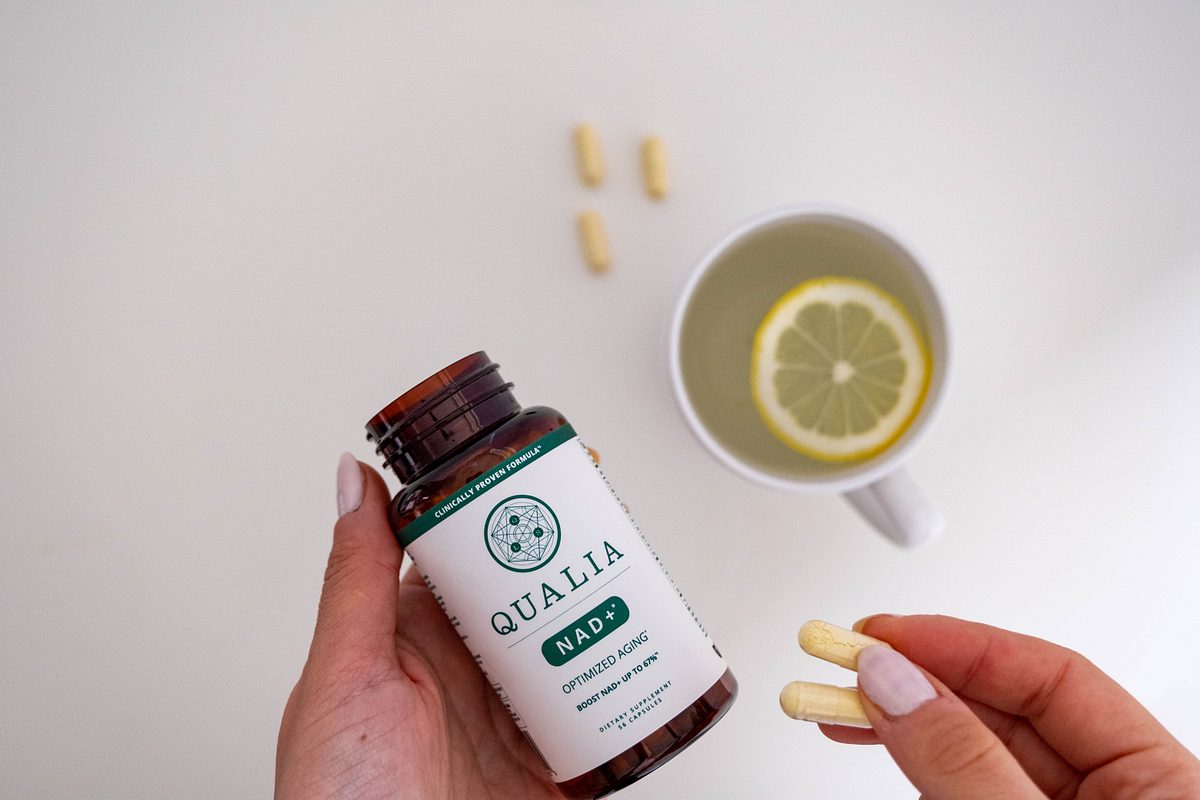
Let’s talk about aging.
If you’re in your late 30s, 40s, or beyond and you’ve started feeling like your body isn’t bouncing back like it used to, you’re probably not imagining things. Maybe you’re a little stiffer after a workout. Or maybe you’re skipping the workout altogether because you have zero energy.
Whatever it looks like, the truth is this: your body is changing.
But here’s the good news—so is the science.
We’re in a golden age of research when it comes to aging well and staying energized!
And one of the most exciting discoveries is a molecule your body already makes that plays a huge role in how youthful, strong, and resilient you feel.
It’s called NAD+ (short for nicotinamide adenine dinucleotide… and no, you don’t need to remember that).
Since April is Stress Awareness Month… you’ll want to know that NAD+ also helps regulate your stress response and enhances mitochondrial function so you’re more resilient and less reactive.*
Here’s why this powerful coenzyme needs to be on your radar—and how to actually raise your levels without breaking the bank or heading to Hollywood for an IV drip.
Why NAD+ Is a Big Deal
NAD+ is found in every living cell in your body, and it’s involved in almost every major function that keeps you feeling energized, focused, and vibrant.
Here’s a quick breakdown of what NAD+ does for you:
- Boosts energy production by fueling your mitochondria (your cellular power plants).
- Supports DNA repair, which is critical for healthy aging.
- Keeps your brain sharp by supporting neurotransmitter and neuron health.
- Optimizes metabolism so your body can better burn fat and sugar.
- Maintains muscle strength, which naturally declines with age.
When your levels are high, everything runs better.
The Problem: NAD+ Levels Drop With Age
Here’s the kicker—your NAD+ levels naturally decline as you age. By the time you hit your 40s, your levels are about half of what they were in your 20s. And it just keeps dropping from there.
So if you’re wondering why your energy, recovery, or focus feels off, this could be part of the answer.
So, Can You Just Take NAD+?
Not exactly. The molecule is too big to absorb efficiently when taken directly. And while NAD+ IVs are trendy (especially in certain zip codes), they’re pricey, inconvenient, and not always reliable.
But there’s a smarter way. Your body can make more NAD+—you just have to give it the right building blocks.
The Smarter Way to Boost NAD+ Naturally
These building blocks are called NAD+ precursors, and the three most important are:
- Niacin (Vitamin B3)
- Niacinamide (a different form of B3)
- Nicotinamide Riboside (NR, sold as NIAGEN™)
Individually, they help a little bit. But together, in the right amounts, they do something amazing.*
To really get the full benefit, your body also needs magnesium, bioavailable B vitamins, and powerful antioxidants like trans-resveratrol to support the whole NAD+ production process.*
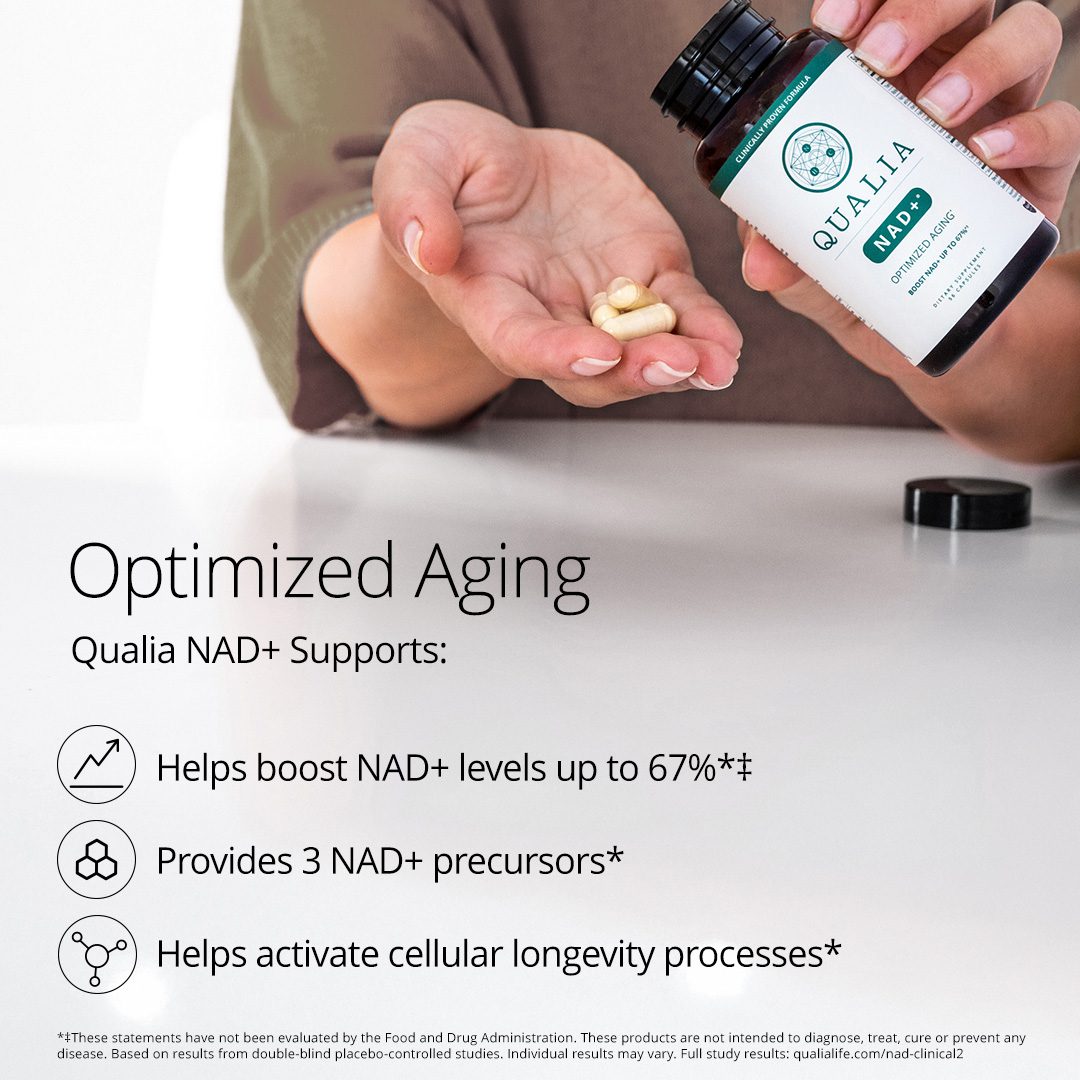
Clinically Proven: A 67% Boost in NAD+
One formula has taken this science to the next level: Qualia NAD+.
This supplement stacks the right forms of precursors with supportive nutrients and then proves its effectiveness through double-blind, placebo-controlled studies.
The result? A clinically confirmed 67% increase in NAD+ levels.*‡
That’s the kind of data that gets me excited. Real results, real people—not hype or gimmicks.
And the best part? You don’t need a private clinic or Hollywood budget to make it happen.
Right now, you can get up to 50% off your first bottle of Qualia NAD+, and use code REIGNITEWELLNESS at checkout for an extra 15% off.
Click here to learn more and try it now →
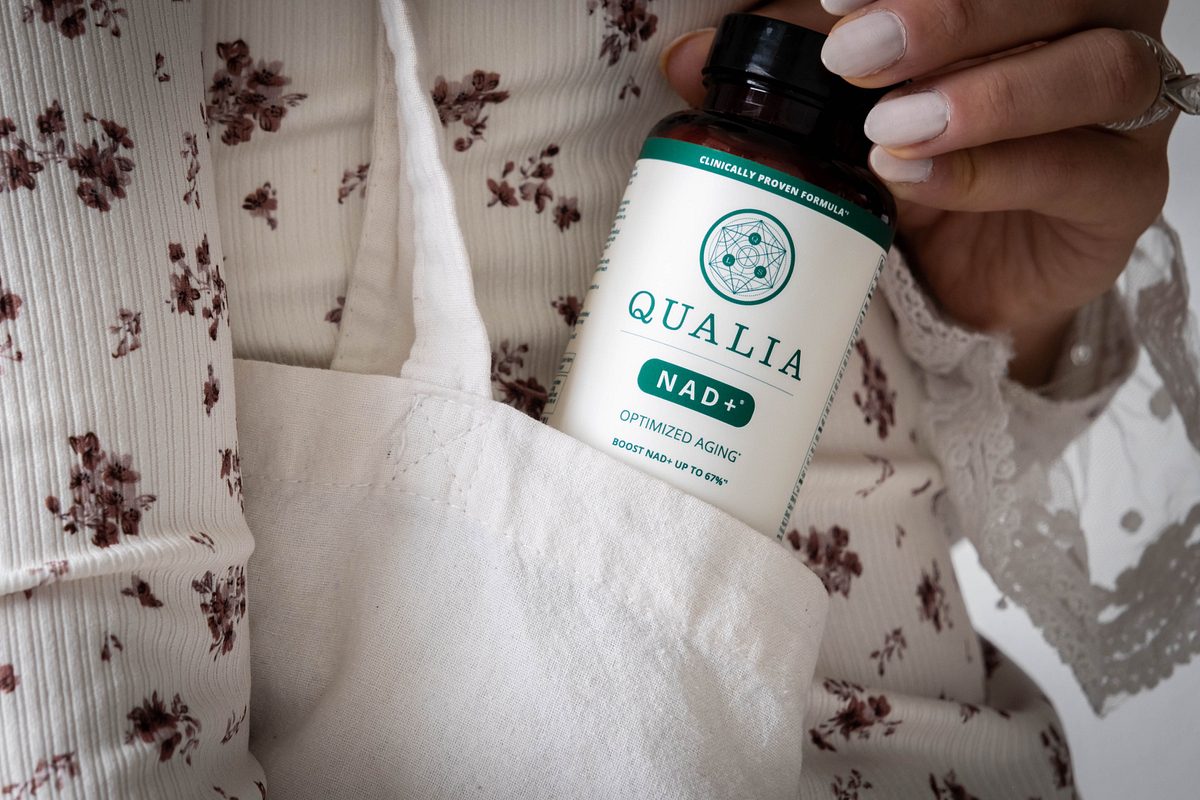
My Personal Experience
I’ve been using NAD+ precursors for a while now, and I’ve noticed a real difference.
I’m powering through my workouts, showing up with energy for long days, and recovering faster—without needing to crash on the couch afterward.
Honestly, it reminds me of how I felt in my 20s—when I had energy to burn, and I didn’t think twice about moving from one thing to the next.
And now? In my 60s? That spark is back.
Final Thoughts
No supplement is magic. But NAD+ is about as close to foundational as it gets when it comes to aging powerfully.
And thanks to cutting-edge formulas like Qualia NAD+, it’s now within reach for all of us—not just celebrities and biohackers.
So if you’re ready to invest in your future self and take control of your energy, strength, and vitality… NAD+ should be on your list.
Your best years aren’t behind you.
They’re just getting started.
Note: You can get up to 50% off and an extra 15% with code REIGNITEWELLNESS. That’s real value for a formula that’s been clinically proven to elevate your NAD+ levels by 67%. Try it here.
Nicotinamide adenine dinucleotide (NAD+) is a molecule that helps regulate the body’s response to stress. NAD+ levels can decrease due to chronic stress, poor diet, and other factors. Low NAD+ levels can contribute to mental health issues and other diseases.
*These statements have not been evaluated by the Food & Drug Administration. Products mentioned are not intended to diagnose, treat, cure, or prevent any disease. The views in this blog by JJ Virgin should never be used as a substitute for professional medical advice. Please work with a healthcare practitioner concerning any medical problem or concern.
The post Why NAD+ Is the Secret to Aging Powerfully (…and Beating Stress!) appeared first on JJ Virgin.
The Best Nutrients to Support Heart Health 1 Feb 10:00 PM (3 months ago)

Heart disease is the leading cause of death among women in the United States, affecting over 60 million and accounting for 1 in 5 deaths. Alarmingly, only 56% of women recognize it as their top health risk.1
While genetics and lifestyle play a role, the good news is that you can take control of your heart health through simple, effective strategies. Healthy habits like eating enough protein and having a regular strength training routine can help you maintain muscle mass, manage weight, and boost your metabolism—all critical factors in keeping your heart strong.
Incorporating heart-healthy nutrients into your meals can further increase your efforts, laying the foundation for a longer, healthier life.
4 Nutrients to Support Heart Health
1. Magnesium: The Heart’s Essential Mineral
Magnesium helps maintain a steady heartbeat and supports the function of your heart and blood vessels. By regulating the electrical signals that control your heart’s rhythm, magnesium promotes healthy blood pressure, which can significantly reduce your risk of heart disease. Magnesium also prevents calcium buildup in your arteries, keeping blood vessels flexible and reducing stiffness.2-4
The recommended daily intake for women 31 and older is 320mg.5 To reach this amount, eat magnesium-rich foods like spinach, kale, almonds, cashews, pumpkin seeds, chia seeds, black beans, and lentils. While these foods are excellent sources, getting enough magnesium from diet alone can be difficult. A high-quality magnesium supplement can ensure your heart gets the support it needs to stay strong and healthy.
This is one of my top recommendations on supplements for women going through perimenopause as heart-protective estrogen declines.
Magnesium Body Calm provides 300mg of highly absorbable magnesium per serving. Our patented process ensures superior absorption, allowing you to experience the many benefits of this mineral without digestive discomfort typical of many magnesium supplements. This versatile formula supports heart health, bone strength, muscle relaxation, a sense of calm to manage stress, and more.*
2. Omega-3 Fatty Acids: The Anti-Inflammatory Powerhouse
Chronic inflammation is a major contributor to heart disease, damaging blood vessels and accelerating plaque buildup in your arteries. Omega-3 fatty acids help lower inflammation, reducing your risk.6, 7
These essential fats lower triglycerides (a type of fat in the blood) and support healthy cholesterol levels, both critical for keeping your heart strong. High triglycerides can increase your risk of heart attack, while balanced cholesterol levels help prevent plaque buildup in your arteries. Omega-3s also promote the elasticity of blood vessels, ensuring smooth blood flow and reducing the likelihood of arterial plaque development.8-10
Wild-caught fatty fish like salmon, mackerel, and sardines are rich in EPA and DHA, the most powerful omega-3s for heart health. You’ll want to supplement with omega-3s if you’re not regularly eating wild-caught fish several times a week.
Omega Plus delivers 1,000 mg of EPA and DHA in just one softgel. This highly bioavailable omega-3 supports heart, brain, and joint health, ensuring maximum benefits with every dose. Omega Plus uses sustainably sourced, purified ingredients to ensure exceptional quality, optimizing it for superior absorption and digestibility.*
3. Vitamin D: The Sunshine Vitamin for a Strong Heart
Vitamin D, often called the “sunshine vitamin,” helps regulate blood pressure, relaxes blood vessels, and reduces heart strain. By promoting calcium absorption, vitamin D prevents calcium buildup in your arteries, a key factor in heart disease. Additionally, its anti-inflammatory properties offer further protection for your heart. Research links vitamin D deficiencies to an increased risk of cardiovascular issues.11-13
While some foods, like wild-caught salmon and egg yolks, contain vitamin D, it’s challenging to meet your needs through diet alone. Sunlight is crucial for vitamin D production, but many people don’t get enough exposure to UV rays to synthesize adequate levels.14
A supplement is your best bet to ensure your heart gets the necessary nutrient support. When choosing a vitamin D supplement, look for one that also includes vitamin K. These two vitamins work together to regulate calcium in the body. Vitamin D helps absorb calcium, and vitamin K ensures that the calcium goes to the right places, like your bones, rather than accumulating in your arteries. This combination supports bone health and prevents calcium buildup in blood vessels, further protecting your heart.15
Strengthen heart health and overall vitality with Vitamin D Plus, a powerful supplement designed to support cardiovascular function, immune health, and bone strength. Featuring 5,000 IU of highly absorbable vitamin D, it promotes optimal heart and immune support, while the synergistic blend of vitamin K1 and K2 enhances cardiovascular and bone benefits and geranylgeraniol (GG) to boost cellular health – all in one easy-to-take softgel.*
4. Fiber: The Heart’s Protective Nutrient
Fiber can help lower cholesterol, regulate blood sugar, and support a healthy weight—critical factors in heart protection. Different types of fiber contribute uniquely to this effort. Soluble fiber binds to LDL (“bad”) cholesterol in your digestive system, aiding its removal and lowering heart disease risk. Insoluble fiber promotes digestion and helps eliminate excess cholesterol. Additionally, prebiotic fiber feeds beneficial gut bacteria, which can reduce inflammation, improve cholesterol levels, and aid in blood pressure regulation.16-18
To get those benefits, aim for 50g of fiber daily. Gradually increase your intake until you reach that number—don’t do it all at once! Focus on high-fiber foods like berries, avocados, gluten-free oats, beans, lentils, and vegetables, which offer a blend of soluble and insoluble fibers. To boost your prebiotic intake, include foods like garlic, onions, leeks, asparagus, and unripe bananas.
Extra Fiber combines 12 natural fibers from fruits, vegetables, and other food sources to promote gut health and balanced wellness. Each serving provides 3 grams of soluble and insoluble fiber, supporting satiety and weight management while nourishing beneficial gut bacteria with prebiotics like acacia gum and inulin. This gluten-free, dairy-free, soy-free, and non-GMO powder easily dissolves in any beverage or recipe, allowing you to boost your fiber intake without altering taste or texture.*
Nutrient Support for a Healthy Heart Well Beyond 40
The nutrients you consume have a direct impact on your heart health. Following the right nutrient plan can significantly enhance both physical and mental well-being. After 40, maintaining a balance of essential nutrients is crucial for supporting cardiovascular health and overall vitality. The right nutrients can boost your energy, improve sleep quality, and reduce brain fog, making it easier to navigate the challenges of menopause and aging.
My Powerhouse Protocol: The Ultimate Powerful Aging Supplement Guide for Women 40+ provides a complete roadmap to vibrant aging through strategic supplementation. This guide empowers you to achieve sustainable energy, balanced hormones, and a revitalized metabolism. With foundational supplements that address common issues like sleep disturbances and cognitive clarity, you’ll experience deep, restorative sleep, consistent energy, and sharp focus.
Inside, you’ll find the essential nutrients that fuel my daily powerful-aging routine, helping you unlock the secret to vibrant aging and your most energized self. Embrace the power of nutrition and supplementation to support your journey toward optimal health!
Get your FREE guide here.
References:
- Centers for Disease Control and Prevention: About Women and Heart Disease
- Everyday Health: How Magnesium Keeps Your Heart Rhythm Healthy
- DiNicolantonio JJ, Liu J, O’Keefe JH. Magnesium for the prevention and treatment of cardiovascular disease. Open Heart. 2018 Jul 1;5(2):e000775. doi: 10.1136/openhrt-2018-000775. PMID: 30018772; PMCID: PMC6045762.
- Cunha AR, Umbelino B, Correia ML, Neves MF. Magnesium and vascular changes in hypertension. Int J Hypertens. 2012;2012:754250. doi: 10.1155/2012/754250. Epub 2012 Feb 29. PMID: 22518291; PMCID: PMC3299255.
- Healthline: Magnesium Dosage: How Much Should You Take per Day?
- Alfaddagh A, Martin SS, Leucker TM, Michos ED, Blaha MJ, Lowenstein CJ, Jones SR, Toth PP. Inflammation and cardiovascular disease: From mechanisms to therapeutics. Am J Prev Cardiol. 2020 Nov 21;4:100130. doi: 10.1016/j.ajpc.2020.100130. PMID: 34327481; PMCID: PMC8315628.
- MedlinePlus: Omega-3 fats – Good for your heart
- Cleveland Clinic: Omega-3 Fatty Acids & the Important Role They Play
- Cleveland Clinic: How Triglycerides Impact Heart Health
- DiNicolantonio JJ, O’Keefe JH. The Benefits of Omega-3 Fats for Stabilizing and Remodeling Atherosclerosis. Mo Med. 2020 Jan-Feb;117(1):65-69. PMID: 32158053; PMCID: PMC7023944.
- National Institutes of Health: Vitamin D – Health Professional Fact Sheet
- Anticancer Research: Vitamin D and Cardiovascular Disease
- American Heart Association Journals: Vitamin D and Your Heart
- UCLA Health: How much sunshine do I need for enough vitamin D?
- Healthline: Is Vitamin D Harmful Without Vitamin K?
- Harvard Health: Fiber-full eating for better health and lower cholesterol
- Better Health Channel: Dietary fibre
- Slavin J. Fiber and prebiotics: mechanisms and health benefits. Nutrients. 2013 Apr 22;5(4):1417-35. doi: 10.3390/nu5041417. PMID: 23609775; PMCID: PMC3705355.
*These statements have not been evaluated by the Food & Drug Administration. Products mentioned are not intended to diagnose, treat, cure, or prevent any disease. The views in this blog by JJ Virgin should never be used as a substitute for professional medical advice. Please work with a healthcare practitioner concerning any medical problem or concern.
The post The Best Nutrients to Support Heart Health appeared first on JJ Virgin.
How Menopause Can Change Your Skin 18 Jan 10:00 PM (3 months ago)

Menopause is more than just a change in reproductive health—it’s a transformation that impacts your entire body. One of the most noticeable areas affected is your skin. As hormonal shifts occur, you may experience reduced elasticity, thinning, dryness, and an increase in wrinkles. These changes can be surprising and have an impact on your confidence.
But with the right knowledge and proactive skincare, you can maintain a healthy, glowing complexion during this phase of life.
Understanding the Role of Estrogen in Skin Health
Estrogen plays a crucial role in maintaining youthful, healthy skin. This hormone supports the production of collagen and elastin—essential proteins that provide skin structure, flexibility, and resilience. However, as you enter menopause and estrogen levels decline, the production of collagen and elastin decreases, leading to less firm and elastic skin.2-4
The impact of reduced estrogen is significant: it can reduce your body’s production of collagen by 2% every year post-menopause.5 This decline manifests as sagging skin, particularly around your jawline, cheeks, and neck, as well as increased dryness and more noticeable wrinkles. Estrogen helps your skin retain moisture and maintain thickness, so its decrease leads to a drier, more fragile complexion, fundamentally altering your skin’s appearance and feel.
3 Ways Menopause Can Impact Your Skin
1. Loss of Firmness and Elasticity
As you progress through menopause, you’ll likely notice significant changes in your skin’s resilience. Decreased collagen and elastin production means your skin loses its ability to bounce back.6
You may see these changes most prominently around your jawline and cheeks, where sagging can alter your facial contours. The loss of elasticity makes your skin more vulnerable to gravity, potentially resulting in jowls and drooping in your lower face and neck, making your overall appearance less youthful.
2. Thinning Skin and Increased Wrinkles
One of the most noticeable changes during menopause is thinning skin. With lower estrogen levels, your skin’s outer layer becomes fragile, making it susceptible to damage. Studies show that skin thickness can decrease by 1.13% annually in women with low estrogen.
This thinning, coupled with slower cell production and reduced moisture retention, leads to more pronounced wrinkles and fine lines, as your skin’s natural plumping effects fade. A weakened protective barrier also leaves your skin vulnerable to UV rays and environmental pollutants, accelerating the aging process.7, 8
3. Decreased Oil Production and Skin Dryness
The drop in estrogen slows down oil production, depriving your skin of its built-in moisturizer. This leads to rough, dull skin that feels tight, especially after cleansing. Increased moisture loss can result in flakiness and uncomfortable itchiness, making your complexion feel perpetually thirsty for hydration.
It’s essential to adopt a more intensive moisturizing routine to compensate for your skin’s reduced ability to retain moisture naturally.9
How to Manage Menopause-Related Skin Changes
Adopt a Proactive Skincare Routine
Taking care of your skin during menopause doesn’t have to be complicated. One key step is incorporating skincare products like retinoids and peptides that help boost collagen production. Retinoids, derived from vitamin A, can stimulate collagen production and reduce the appearance of wrinkles, while peptides act as messengers that signal your skin to produce more collagen.10, 11
Hydration is also crucial for your skin during menopause. Look for products containing hyaluronic acid, which acts like a sponge to retain moisture, and ceramides, which strengthen your skin’s barrier to lock in hydration and keep irritants out. When cleansing, go for gentle, creamy cleansers that won’t strip away your skin’s natural oils because harsh soaps can exacerbate dryness.
Here are a few items that are currently in my skincare routine:
- Delavie Sciences Age Defying Serum, an antioxidant-rich serum that helps restore moisture and reduce visible signs of aging.
- Estro2 Rejuvenate by Karen Martel, a face cream with bioidentical estradiol and estriol to combat skin aging, wrinkles, and pores, while also supporting mood, energy, vaginal health, and weight.
- OneSkin for menopausal skin challenges like dryness and loss of elasticity.**
- Timeline Skincare powered by Mitopure, a powerful urolithin A molecule clinically proven to enhance the skin’s natural energy supply, supporting cellular renewal from within.**
Drink Enough Water
Topical hydration is great for your skin, but you also want to hydrate from the inside out. Drinking enough water helps keep skin cells plump and resilient, which can diminish the appearance of fine lines and wrinkles.12 This handy calculator can help determine how much water you need daily.
Your diet also impacts your skin. Focus on skin-supportive foods rich in antioxidants, healthy fats, and essential vitamins. Colorful, low-sugar fruits like berries and vegetables protect your skin from damage, while healthy fats found in avocados and nuts help maintain suppleness. Vitamins C and E are particularly important, as they support collagen production and skin repair.13-15
Optimize Protein Intake
Increasing your protein intake can significantly benefit your skin during menopause. Protein is essential for collagen production and skin repair, playing a vital role in cell regeneration to maintain a youthful complexion. As your skin cells naturally turnover, protein ensures that new, healthy cells are ready to take their place.16, 17
Aim for 30-50 grams of protein at every meal (and 100+ grams protein daily) to support this process. Focus on high-quality protein sources, such as grass-fed/grass-finished meat, wild-caught fish, and pastured eggs if you can tolerate them. These foods provide protein and other nutrients that benefit your skin like the omega-3 fatty acids in fatty fish that can help keep your skin supple and moisturized.18

Manage Stress Effectively
Stress is one of the best ways to age yourself fast. Chronic stress can exacerbate skin issues during menopause, acting like fuel on the fire. Elevated cortisol levels increase inflammation, making your skin more susceptible to breakouts and redness, potentially accelerating the aging process.19
To counteract these effects, prioritize stress management. Incorporate practices like meditation and mindfulness, which can calm your mind and lower cortisol levels, allowing your skin to recover. Yoga and deep breathing exercises are also effective, promoting relaxation and improving circulation to deliver more oxygen and nutrients to your skin cells.
Prioritize Quality Sleep
During sleep, your body repairs and regenerates skin, increasing blood flow, rebuilding collagen, and combating daily damage.20 When you don’t get enough sleep, you might notice dullness, puffiness, and even more pronounced wrinkles.
Aim for 7-9 hours of sleep each night to allow your skin to rejuvenate. Stick to a consistent sleep schedule, even on weekends, and create a relaxing bedtime routine—whether that’s reading, taking a warm bath, or doing gentle stretches. Make your bedroom sleep-friendly by keeping it cool, dark, and quiet, too. Consider using a quality sleep supplement that contains melatonin and other calming nutrients to help you drift off more easily.*
Sleep&Glow creates cutting-edge sleep products that boost both sleep quality and beauty. Their signature Omnia pillow helps prevent sleep wrinkles and reduces morning puffiness, while their blankets, loungewear, and supplements support different aspects of restful sleep. By blending ergonomic design with sleep-enhancing materials, Sleep&Glow is dedicated to improving sleep and overall wellness. Shop Sleep&Glow and use code jjvirgin for $20 off pillows and blankets.**
Use Sun Protection
Research shows that UV exposure is responsible for up to 80% of visible skin aging, including dryness, flaking, wrinkles, and uneven pigmentation. It also increases your risk of skin cancer. During this time, when your skin is more vulnerable, sun protection becomes even more crucial.21, 22
Make it a habit to apply broad-spectrum sunscreen with at least SPF 30 part of your daily routine, regardless of the weather. Be sure to cover all exposed skin, including your face, neck, and hands. Embrace a multi-layered approach by wearing protective clothing like wide-brimmed hats, long-sleeved shirts, and sunglasses. You can enjoy the outdoors—just be smart about protecting your skin from the sun’s damaging effects.
Supplement with Collagen
Collagen peptide supplements can be a powerful ally in your fight against menopause-related skin changes. As you age, especially during menopause, your body’s natural collagen production slows down significantly. Collagen provides the essential building blocks to support skin health from the inside out.23
Supplementing with collagen can enhance moisture retention and elasticity. Studies show women who take collagen peptides regularly experience noticeable skin hydration and elasticity improvements. Some research even suggests that these supplements can help reduce the appearance of wrinkles.24, 25
Essential Tips for a Radiant Complexion
Menopause can bring significant changes to your skin, often accelerating the aging process. But with the right strategies, you can effectively manage these changes and maintain a healthy, vibrant complexion. That’s why I created Inner Wellness, Outer Beauty: Your Anti Aging Cheat Sheet to provide the tips and tools I use to keep my skin looking its best during this transition.
This guide offers my top tips on the best foods, key nutrients, and lifestyle changes to support your skin health during menopause. While you can’t control hormonal shifts, you can give your skin the care it needs—and this guide will show you how. Whether you’re facing dryness, loss of elasticity, or other concerns, this cheat sheet provides the knowledge to keep your skin radiant through menopause and beyond.
Get your FREE copy of Inner Wellness, Outer Beauty: Your Anti-Aging Cheat Sheet here.
References:
- American Academy of Dermatology: Caring for your skin in menopause
- Stevenson S, Thornton J. Effect of estrogens on skin aging and the potential role of SERMs. Clin Interv Aging. 2007;2(3):283-97. doi: 10.2147/cia.s798. PMID: 18044179; PMCID: PMC2685269.
- Cleveland Clinic: Elastin: What it is, Structure, Function & Supplements
- Cleveland Clinic: Collagen: What It Is, Types, Function & Benefits
- Thornton MJ. Estrogens and aging skin. Dermatoendocrinol. 2013 Apr 1;5(2):264-70. doi: 10.4161/derm.23872. PMID: 24194966; PMCID: PMC3772914.
- Healthline: Understanding How Your Skin Changes During Menopause
- Thornton MJ. Estrogens and aging skin. Dermatoendocrinol. 2013 Apr 1;5(2):264-70. doi: 10.4161/derm.23872. PMID: 24194966; PMCID: PMC3772914.
- Vogue: Why Estrogen Is a Magic Bullet for Your Skin and Vaginal Health
- WebMD: Tips for Better Skin After Menopause
- Harvard Health: Do retinoids really reduce wrinkles?
- Allure: How This Ingredient Helps Build Collagen for Firmer Skin
- Clinikally: How to Hydrate Skin for Plumper & Healthier Skin
- EatingWell: 5 Antioxidant Foods to Protect Your Skin From Sun Damage
- Healthline: The 12 Best Foods for Healthy Skin
- Traber MG, Stevens JF. Vitamins C and E: beneficial effects from a mechanistic perspective. Free Radic Biol Med. 2011 Sep 1;51(5):1000-13. doi: 10.1016/j.freeradbiomed.2011.05.017. Epub 2011 May 25. PMID: 21664268; PMCID: PMC3156342.
- Healthline: 13 Foods That Help Your Body Produce Collagen
- Alton Memorial Hospital: High-Protein Diet for Wound Care
- Healthline: Potential Benefits of Omega-3s for Skin and Hair
- Chen Y, Lyga J. Brain-skin connection: stress, inflammation and skin aging. Inflamm Allergy Drug Targets. 2014;13(3):177-90. doi: 10.2174/1871528113666140522104422. PMID: 24853682; PMCID: PMC4082169.
- Healthline: Beauty sleep: Is it real?
- Amaro-Ortiz A, Yan B, D’Orazio JA. Ultraviolet radiation, aging and the skin: prevention of damage by topical cAMP manipulation. Molecules. 2014 May 15;19(5):6202-19. doi: 10.3390/molecules19056202. PMID: 24838074; PMCID: PMC4344124.
- Healthline: Understanding How Your Skin Changes During Menopause
- Al-Atif H. Collagen Supplements for Aging and Wrinkles: A Paradigm Shift in the Fields of Dermatology and Cosmetics. Dermatol Pract Concept. 2022 Jan 1;12(1):e2022018. doi: 10.5826/dpc.1201a18. PMID: 35223163; PMCID: PMC8824545.
- Bolke L, Schlippe G, Gerß J, Voss W. A Collagen Supplement Improves Skin Hydration, Elasticity, Roughness, and Density: Results of a Randomized, Placebo-Controlled, Blind Study. Nutrients. 2019 Oct 17;11(10):2494. doi: 10.3390/nu11102494. PMID: 31627309; PMCID: PMC6835901.
- Pu SY, Huang YL, Pu CM, Kang YN, Hoang KD, Chen KH, Chen C. Effects of Oral Collagen for Skin Anti-Aging: A Systematic Review and Meta-Analysis. Nutrients. 2023 Apr 26;15(9):2080. doi: 10.3390/nu15092080. PMID: 37432180; PMCID: PMC10180699.
*These statements have not been evaluated by the Food & Drug Administration. Products mentioned are not intended to diagnose, treat, cure, or prevent any disease. The views in this blog by JJ Virgin should never be used as a substitute for professional medical advice. Please work with a healthcare practitioner concerning any medical problem or concern.
**I couldn’t make it without supportive relationships, and I bet you feel the same! That’s why my team and I offer you products and services we believe in. If you happen to purchase something I recommend here, I may receive some kind of compensation. However, I only bring you partners whose content and core values will serve you with the same commitment to excellence my team and I strive for every day. Please be in touch with any concerns.
The post How Menopause Can Change Your Skin appeared first on JJ Virgin.
5 Easy Tips for Better Digestion 11 Jan 10:00 PM (3 months ago)

Digestive health is essential for your overall well-being and quality of life. When your digestion runs smoothly, you feel energized, comfortable, and ready to take on the day. But when issues like bloating, constipation, or indigestion arise, they can disrupt your daily routine and impact your health in surprising ways.
Think about it: Struggling to zip up your favorite dress because of bloating or worrying about frequent bathroom trips during an important meeting can chip away at your confidence. These discomforts aren’t just minor inconveniences—they’re signals that your digestive system needs support.
The good news is you don’t have to live with these challenges. Let’s explore some easy tips to promote better digestion and help you feel your best.
5 Easy Tips for Better Digestion
1. Eat a High-Fiber Diet
Fiber plays a crucial role in digestion by keeping your gut balanced. It adds bulk to your stool and promotes regular bowel movements, helping to prevent constipation and support a healthy gut microbiome, reducing your risk of digestive issues.1, 2 A healthy microbiome is essential for nutrient absorption, immune function, and even mood regulation, as it influences the production of neurotransmitters.
Soluble fiber, found in foods like oats, beans, and fruit, slows down digestion and helps stabilize blood-sugar levels by preventing rapid spikes. This regulation is important for gut health because stable blood sugar can reduce cravings and overeating, which can lead to digestive discomfort. Additionally, soluble fiber can help lower cholesterol levels by binding to cholesterol in the digestive system and aiding its excretion, contributing to overall cardiovascular health.
Aim for 50g of fiber daily. This might sound like a lot, but you’ll hit that target quickly when you build your meals around high-fiber foods. Be sure to track your current fiber intake, and slowly increase by a few grams every couple of days to allow your body to get used to the additional fiber.
Extra Fiber delivers 12 types of soluble and insoluble fiber from fruits, vegetables, seeds, and tree extracts, including prebiotic fibers like acacia gum and inulin to support gut health. It’s unflavored and unsweetened with no artificial additives, and mixes easily into any drink or smoothie. A simple way to boost your daily intake!*
Tip 2: Stay Hydrated
Hydration is essential for effective digestion. Water helps break down food so nutrients can be absorbed efficiently. It softens food, making it easier for digestive enzymes to do their job and promoting the smooth movement of food through your digestive tract. Staying hydrated also prevents constipation by keeping stool soft and supporting regular bowel movements.3, 4
Drink plenty of water daily to stay hydrated and optimize digestion—a good rule of thumb is to drink half your weight in ounces of water per day. Green tea is another excellent choice; it’s packed with antioxidants and has been shown to support gut health.5 You can boost hydration further by including water-rich foods like cucumbers, watermelon, and strawberries. Loaded smoothies, like this Berry Cobbler Protein Shake, make slipping in these hydrating foods easy and delicious.
Tip 3: Eat Mindfully
In our fast-paced lives, it’s easy to rush through meals, but this habit can negatively impact your digestion. Mindful eating is a powerful practice that enhances your relationship with food and supports digestive health. It involves focusing on your meal—chewing thoroughly and savoring each bite. By paying attention to your food, you allow your digestive system to better process what you consume.
Mindfulness also helps you tune into your body’s hunger and fullness signals, which can prevent overeating. Stress, a common factor in our busy lives, can disrupt digestion by triggering the release of hormones that negatively affect gut function. Mindful eating encourages relaxation, reducing stress levels and promoting better digestion.6
Creating a calm eating environment is key. Put away your phone and turn off the TV to minimize distractions. Chew slowly, listen to your body, and take your time. Mindful eating not only aids digestion by promoting proper food breakdown but also helps prevent overeating and increases overall meal satisfaction.
Tip 4: Take an After-Dinner Walk
Walking after a meal is a simple yet effective way to enhance your digestion. This gentle movement stimulates the muscles in your digestive tract, promoting peristalsis—the process that moves food through your intestines. As you walk, the rhythmic contractions of your abdominal muscles help push food along, reducing bloating and discomfort.
Additionally, walking encourages the production of digestive enzymes, which play a vital role in breaking down food and improving nutrient absorption. This means your body can more efficiently utilize the nutrients in your meal.
Beyond the digestive benefits, a post-meal walk provides an opportunity to relax and enjoy fresh air, which can help lower stress levels. Lower stress contributes to better digestion, as high stress can disrupt the digestive process. A leisurely stroll also helps balance blood sugar levels by promoting the uptake of glucose into cells, preventing spikes that can occur after eating.7, 8
Tip 5: Take Digestive Enzymes Before Meals
Digestive enzymes are essential for breaking down food into absorbable nutrients. These enzymes target specific macronutrients: proteases break down proteins, lipases digest fats, and amylases handle carbohydrates. When food is broken down properly, your body can absorb vitamins, minerals, and other nutrients more efficiently.
As we age or experience stress, our body’s natural production of digestive enzymes can decline. This can lead to incomplete digestion, resulting in symptoms like bloating, gas, and discomfort. Taking digestive enzyme supplements can help bridge this gap by providing additional enzymes that assist in the digestion process.9
By promoting the breakdown of food before it reaches the intestines, digestive enzymes can enhance nutrient absorption. This means more of the beneficial compounds in your food are available for your body to use. Improved digestion can also reduce the workload on your gut, leading to less irritation and inflammation, which are often associated with digestive issues.
Additionally, better digestion can support a healthier gut microbiome. When food is digested properly, it minimizes undigested particles that can lead to imbalances in gut bacteria. Overall, incorporating digestive enzymes into your routine can significantly enhance your digestive health, helping you feel more comfortable and energized after meals.
A Comprehensive Digestive Enzyme to Optimize Digestion
Looking for an easy way to support your digestive health? Protein First Enzymes provide a powerful blend of digestive enzymes and betaine HCl to help your body digest proteins, fats, and carbohydrates. This cutting-edge supplement also targets challenging proteins like gluten and lactose, offering peace of mind when dining out or uncertain about meal ingredients.
If you often feel overly full, bloated, or constipated, Protein First Enzymes may be the solution. Simply take one capsule 10-15 minutes before each meal to enhance digestion and nutrient absorption. This small step can significantly improve how you feel after eating, allowing you to enjoy your meals without discomfort.*
Order Protein First Enzymes here.
References:
- Advent Health: Fiber: Your Digestive System’s Gut Health Hero
- Mayo Clinic: Dietary fiber: Essential for a healthy diet
- Mayo Clinic: Water after meals: Does it disturb digestion?
- Popkin BM, D’Anci KE, Rosenberg IH. Water, hydration, and health. Nutr Rev. 2010 Aug;68(8):439-58. doi: 10.1111/j.1753-4887.2010.00304.x. PMID: 20646222; PMCID: PMC2908954.
- Pérez-Burillo S, Navajas-Porras B, López-Maldonado A, Hinojosa-Nogueira D, Pastoriza S, Rufián-Henares JÁ. Green Tea and Its Relation to Human Gut Microbiome. Molecules. 2021 Jun 26;26(13):3907. doi: 10.3390/molecules26133907. PMID: 34206736; PMCID: PMC8271705.
- Nelson JB. Mindful Eating: The Art of Presence While You Eat. Diabetes Spectr. 2017 Aug;30(3):171-174. doi: 10.2337/ds17-0015. PMID: 28848310; PMCID: PMC5556586.
- NY Times: Just 2 Minutes of Walking After a Meal Is Surprisingly Good for You
- Healthline: The 11 Best Ways to Improve Your Digestion Naturally
- Healthline: Understanding Digestive Enzymes: Why Are They Important?
*These statements have not been evaluated by the Food & Drug Administration. Products mentioned are not intended to diagnose, treat, cure, or prevent any disease. The views in this blog by JJ Virgin should never be used as a substitute for professional medical advice. Please work with a healthcare practitioner concerning any medical problem or concern.
**I couldn’t make it without supportive relationships, and I bet you feel the same! That’s why my team and I offer you products and services we believe in. If you happen to purchase something I recommend here, I may receive some kind of compensation. However, I only bring you partners whose content and core values will serve you with the same commitment to excellence my team and I strive for every day. Please be in touch with any concerns.
The post 5 Easy Tips for Better Digestion appeared first on JJ Virgin.
A Fitness Expert’s Home Gym Essentials 4 Jan 10:00 PM (4 months ago)

Your personal fitness revolution can happen in the comfort of your own home. With just a few versatile essentials, you can turn any corner of your living space into a dynamic workout zone that enhances strength, flexibility, and overall wellness.
Whether a fitness enthusiast or just beginning your journey, these essentials can elevate your exercise routine, improve your recovery, and accelerate your progress toward your health goals. The best part? You don’t need a gym membership to achieve remarkable results.
Here are my favorite tools to make the most of your home workouts.

Exercise Mat
An exercise mat can help you create a dedicated and comfortable workout space in any room. You’ll want it to help cushion and protect your joints during floor exercises, yoga, and stretching. Plus, it protects your floors from wear and tear, especially if you’re using it underneath heavy exercise equipment.
Mats come in varying thicknesses and the one you choose will depend on what you’re using it for. Typical yoga mats that you can use for most workouts are about ⅛-inch thick, but you may want something with a bit more cushioning, like a foam mat, if you’re doing a lot of floor-based exercises.
Dumbbells
Dumbbells are a must-have for resistance training, offering versatility to target all major muscle groups. They enhance functional strength through exercises like bicep curls, shoulder presses, and lunges. As you get stronger, increasing the weight is easy, making dumbbells an excellent long-term investment for building and maintaining muscle.
If you’re not ready to invest in a full set of dumbbells or simply don’t have the space, try an adjustable dumbbell set. This is a space-saving solution that replaces 15 sets of weights and, depending on the set you buy, can offer a range of weight options from 10-50+ lbs per dumbbell. No need to buy a new set of dumbbells every time you want to progress your workouts!

TRX Suspension Trainer
The TRX Suspension Trainer is a game-changer for your fitness routine. It’s a compact, versatile system that uses your body weight to provide a full-body workout. Plus, it’s easily portable so you can take it with you wherever you’re traveling—no excuses!
The TRX is great for helping strengthen and tone your muscles while also improving balance and flexibility. Research shows that suspension training works well for older adults: about 85% of them stick with it, 91% want to keep going, and using it consistently helps build strength.1
It’s easy to adjust exercise difficulty by changing your body position, making it suitable for all fitness levels. TRX is a great option if you’re not ready to invest in a set of dumbbells and still want a challenging, sweat-inducing workout without the bulky equipment.
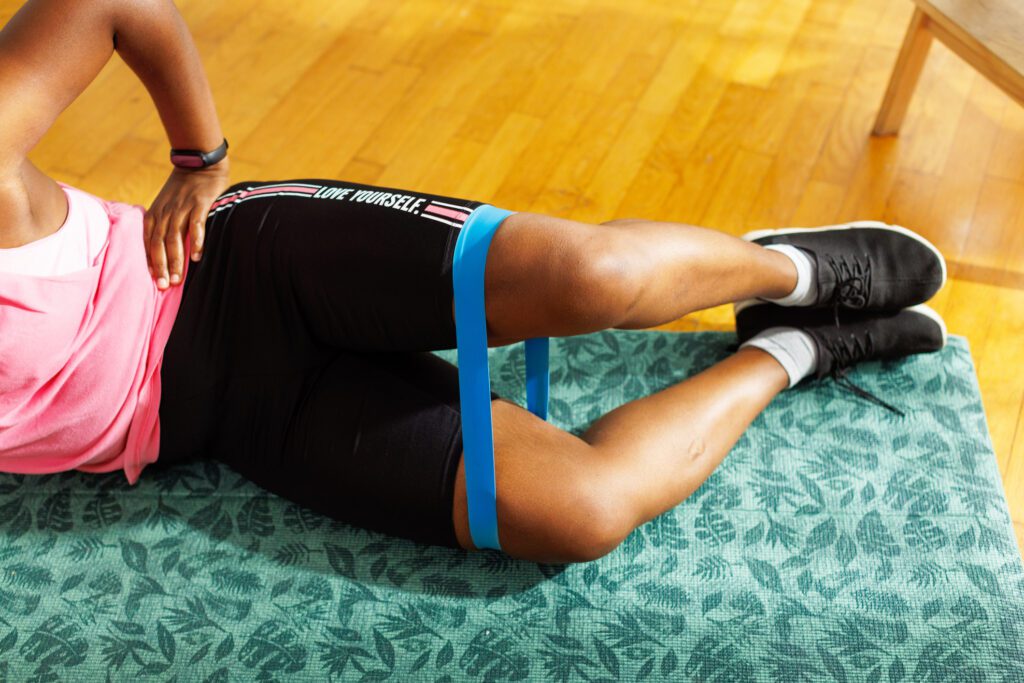
Resistance Bands
Resistance bands are lightweight and portable, easily fitting in your purse or travel bag so you can keep up your workout routine anywhere. Studies show resistance bands can help improve body composition by reducing body fat.2
There are two different types of resistance bands you can choose from. You’ll typically find the loop-style bands made of varying thicknesses of stretchy rubber, which offers different challenge levels. They’re ideal for lower body exercises, mainly targeting glutes and thighs. You can also use them for some upper body pulling exercises like lat pulldowns and band pull-aparts.
You’ll also find longer tube bands with handles. They’re a little bit bulkier than loop-style bands, but still easily portable. You can anchor them by stepping on them, or placing them around door handles, the legs of heavy furniture, hand rails, or other immovable objects.
Opt for a set with multiple levels of resistance, like this option.
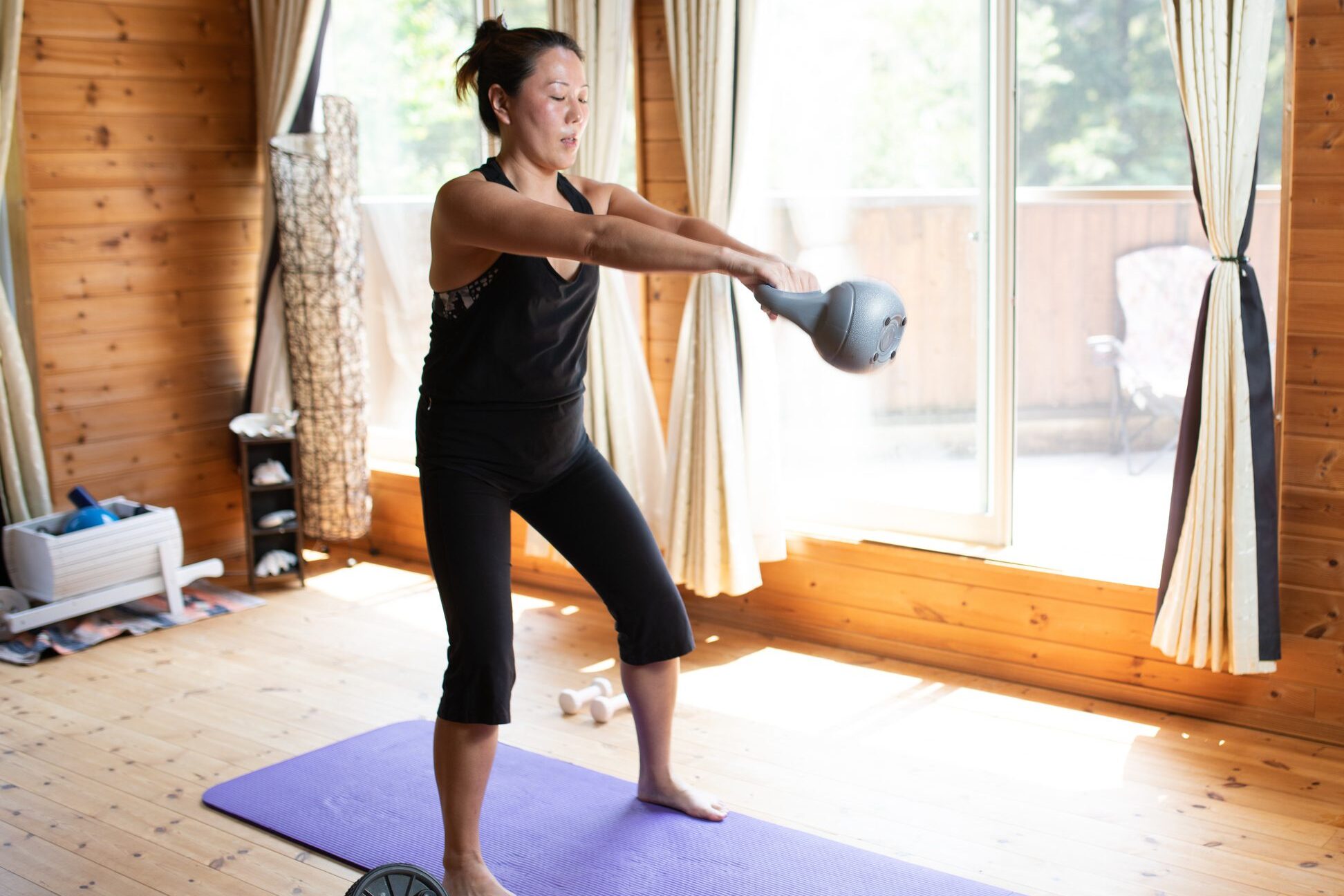
Kettlebells
Kettlebells offer a full-body, functional workout that combines strength, cardio, and mobility in a space-efficient, affordable package. It’s versatile, scalable, and provides a time-efficient way to build strength and endurance.3
You’ve got lots of options when it comes to kettlebell exercises. The kettlebell swing is a go-to that engages the hips, glutes, and core while boosting cardio fitness. You can also use it for goblet squats that focus on the lower body, engaging the core and improving squat form. If you don’t have a set of dumbbells yet, you can use it for single-arm row to target the back while challenging core stability, or hold it while doing Russian twists and strengthening your abs.
I recommend having a few different sizes, and you can find an adjustable version as well to keep things simple. This allows quick and easy weight adjustments without needing multiple kettlebells.
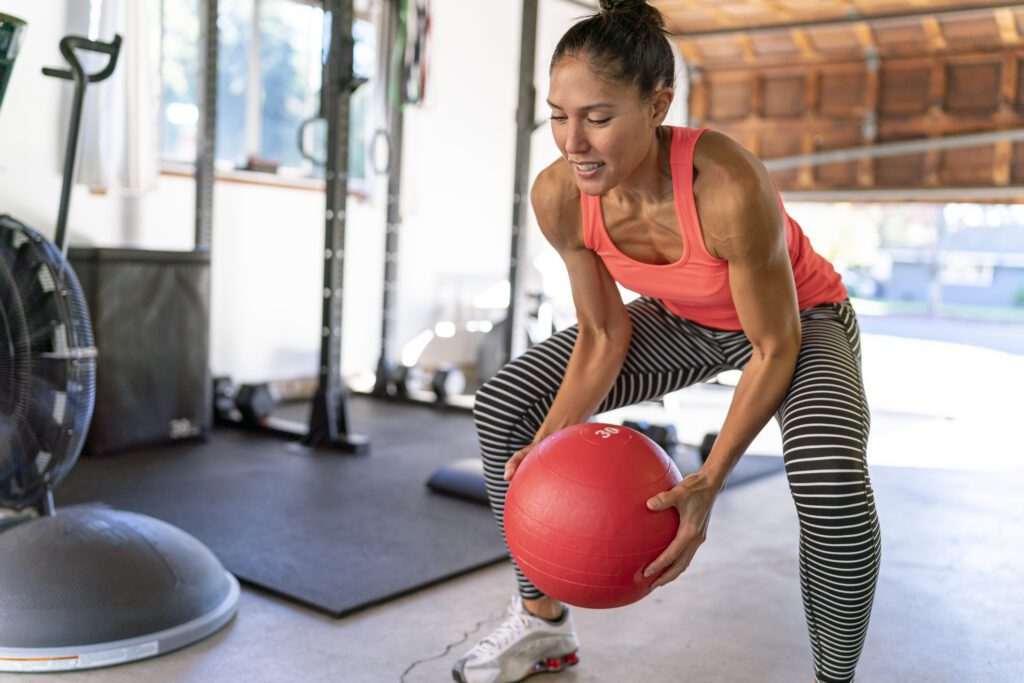
Medicine Ball
Like a kettlebell, a medicine ball is versatile and functional. It can be used for a wide range of exercises that engage multiple muscle groups, improve strength, and boost cardiovascular fitness. While kettlebells are primarily used for dynamic movements and resistance training, medicine balls are excellent for explosive, high-intensity movements, like slams, throws, and rotational exercises, that engage the core and enhance coordination, stability, and power.
Medicine balls are also great for improving functional fitness, flexibility, and mobility through exercises like wall balls, Russian twists, or partner throws. Like kettlebells, they come in various weights, allowing for scalable intensity, and their relatively low cost makes them accessible for home gyms. Both are versatile tools for full-body workouts, making them complementary to one another in a balanced fitness routine.
S with a weight that challenges you without compromising form. For beginners, a 3kg (6 lb) medicine ball is typically a good starting point.
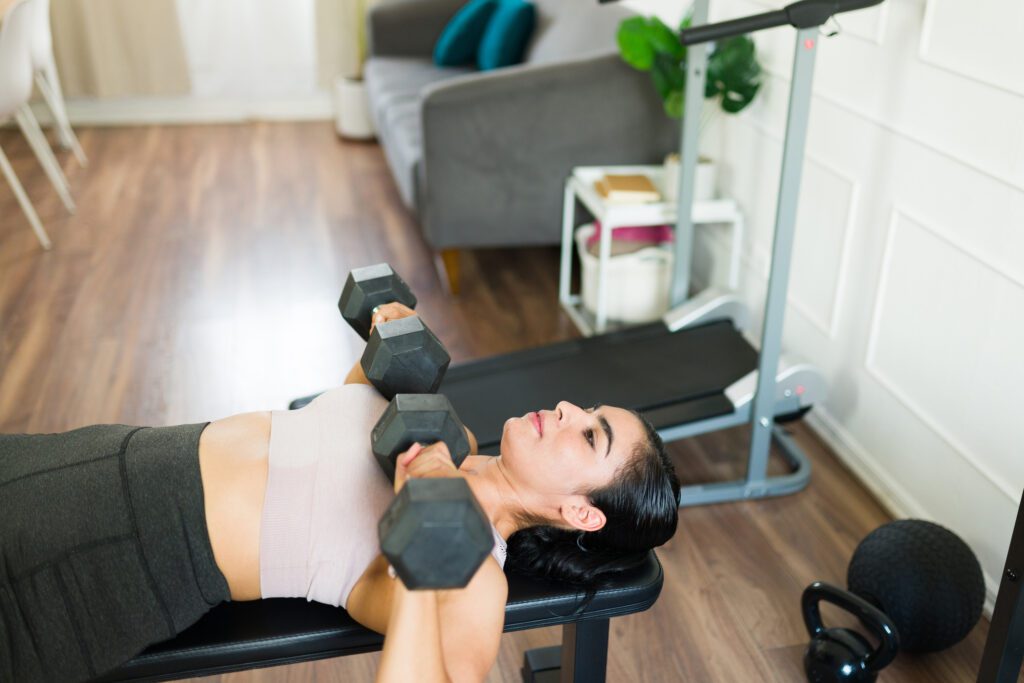
Weight Bench
A weight bench is a must-have for any home gym because it gives you a solid, stable foundation for key strength exercises like bench presses, dumbbell work, and bodyweight moves. It helps you maintain proper form, especially when lifting heavier weights, and expands your workout options by targeting multiple muscle groups, from the chest to the shoulders.
Plus, it’s great for exercises like step-ups and seated movements, making it a game-changer for building strength and sculpting your body.
When choosing a weight bench, look for one that’s adjustable to offer flat, incline, and decline positions for versatility. Make sure it has a solid weight capacity, comfortable padding, and is made from durable materials for stability during lifts. Consider the size for your space and whether it folds for easy storage as well.
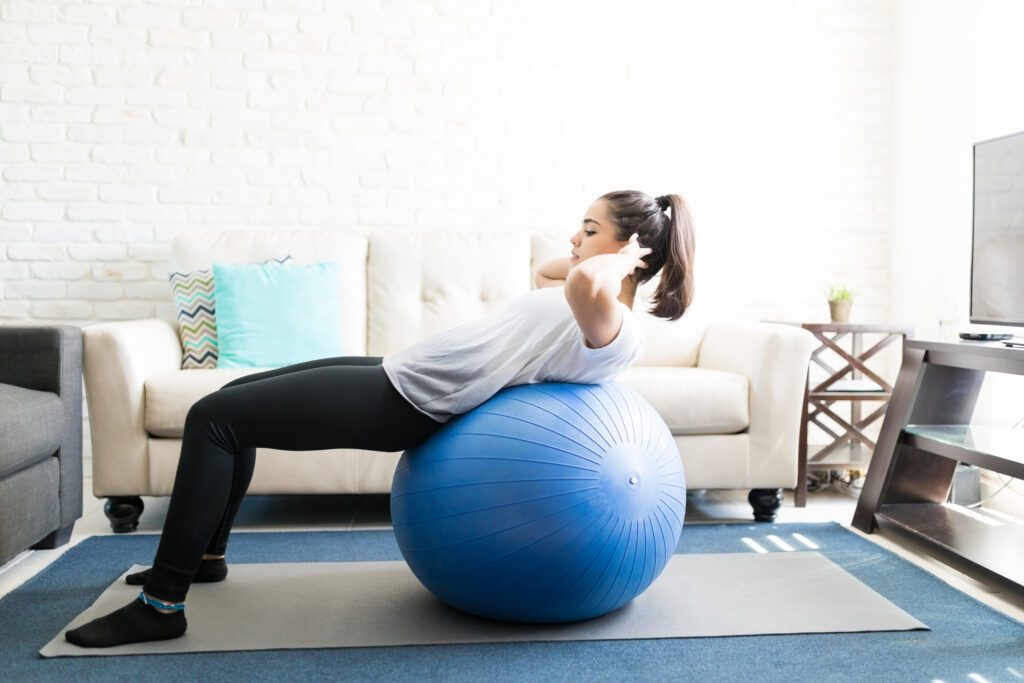
Exercise Ball
An exercise ball challenges your body by providing an unstable surface that strengthens your core, improves balance, and enhances overall fitness. It can be used for a wide range of exercises, from basic crunches to advanced planks and push-ups, and is suitable for all fitness levels.
Beyond core work, it can help you improve your flexibility and posture, and its low-impact nature makes it joint-friendly.
You’ll want to choose the right size ball for your height to ensure proper form. Here are some handy guidelines:
- 5’0″ and under: 45 cm ball
- 5’1″ to 5’7″: 55 cm ball
- 5’8″ to 6’1″: 65 cm ball
Your thighs should be parallel to the ground when seated, and your knees should be at a 90-degree angle. Consider the ball’s inflation level, too—firmer balls are larger and more challenging, while slightly deflated balls offer more stability. If you have a larger frame, opt for a slightly bigger ball for added durability and stability.
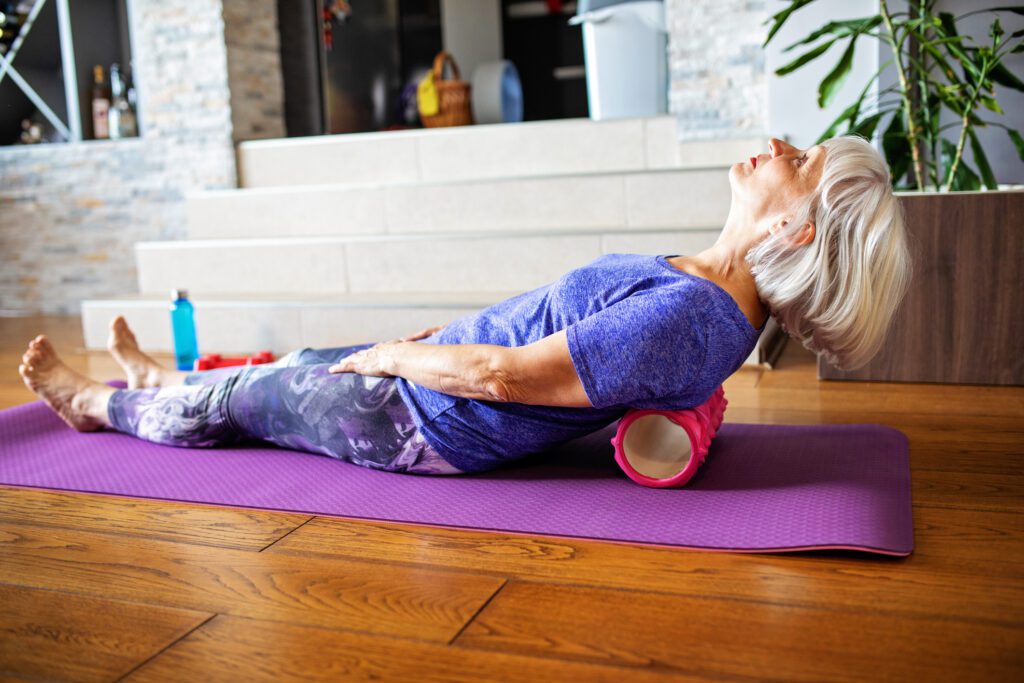
Foam Roller
Recovery is a key—but often overlooked—part of any fitness routine, and a foam roller is one of the best tools to help you recover, improve flexibility, and reduce soreness. This dense foam tube works like a self-massage tool, helping to relax tight muscles, boost blood flow, and release tension after a tough workout. Whether you use it before or after exercise, or even on rest days, foam rolling can help keep your muscles flexible and speed up recovery, making it an essential addition to your fitness toolkit.
You have a few different options. A smooth foam roller is perfect for beginners or anyone with sensitive muscles, offering a gentler, even pressure. For those with more experience or specific muscle issues, a textured foam roller with bumps or ridges will give you a deeper, more intense massage to release knots and tension.
To get the most out of foam rolling, aim to do it 2-3 times a week, focusing on major muscle groups, and spend about 30-60 seconds on each area. Start with light pressure and gradually increase it as you get more comfortable—your muscles will thank you!
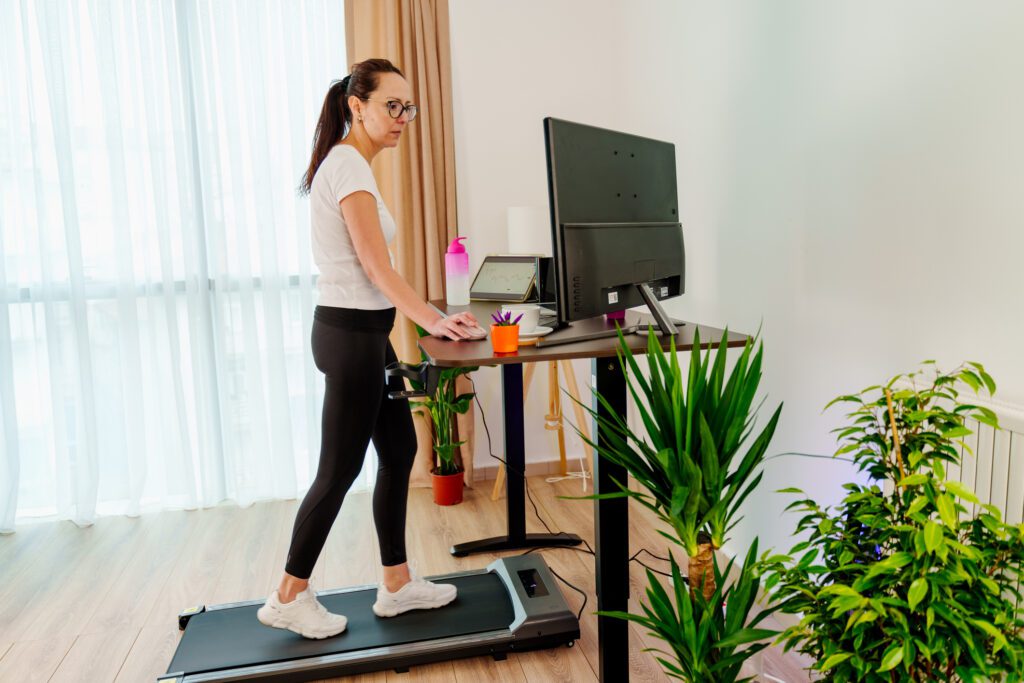
Walking Pad
A walking pad isn’t just essential for your home gym, it’s amazing to have in your office, too! It provides an easy, low-impact way to stay active without taking up valuable space. Keep it under a stand-up desk to use while you’re catching up on emails or listening in on a Zoom meeting. Or get your steps in while watching TV or catching up on a podcast.
You can burn calories, improve your cardiovascular health, and keep your body moving without having to leave the house—great in the winter months. Plus, walking pads are designed to be more compact than treadmills so you can easily store it away when you’re done, making it ideal for those with limited space but big fitness goals.
What I love about a walking pad is that it makes fitness accessible for just about everyone. Whether you’re new to working out or need a recovery day, walking is a great way to stay active without the intensity of running or high-impact exercise. It’s also a powerful tool for breaking up long hours of sitting, especially if you’re working from a desk or spending time on the couch.
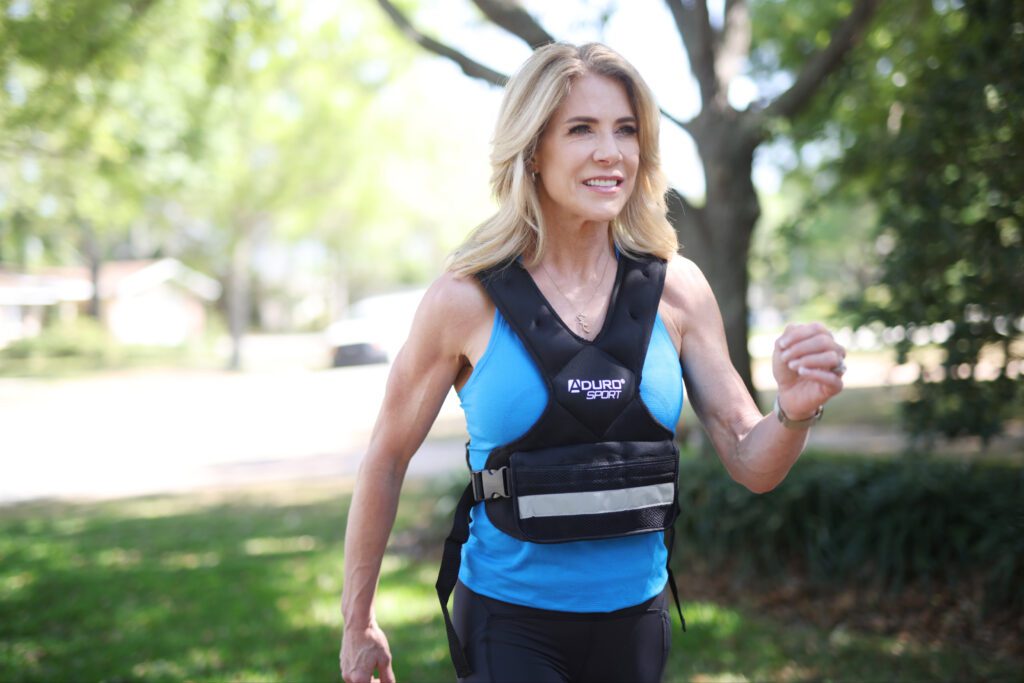
Weighted Rucking Vest
A weighted rucking vest is a must-have for any home gym because it adds an extra level of intensity to your workouts without requiring bulky equipment or space. By adding weighted resistance to exercises like walking (outside or on your walking pad), hiking, or bodyweight movements, you boost calorie burn, increase strength, and challenge your muscles in a whole new way.
It’s an easy way to turn a simple walk into a fat-burning, muscle-building workout—perfect for anyone looking to get more out of their cardio or build endurance without hitting the gym. You can even wear it while doing squats, lunges, push-ups, and more to level up your training. Plus, they’re comfortable and adjustable, allowing you to customize the fit and weight to match your fitness level and goals.
A Powerful At-Home Workout
My Resistance Training Cheat Sheet helps you build your own powerful at-home resistance training program that delivers impressive results, especially for women over 40. With just a few simple tools like resistance bands or your body weight, you can effectively build muscle, boost metabolism, and improve strength and bone density—all crucial as we age.
Download your FREE Resistance Training Cheat Sheet here.
References:
- Gaedtke A, Morat T. TRX Suspension Training: A New Functional Training Approach for Older Adults – Development, Training Control and Feasibility. Int J Exerc Sci. 2015 Jul 1;8(3):224-233. PMID: 27182415; PMCID: PMC4833470.
- Liu X, Gao Y, Lu J, Ma Q, Shi Y, Liu J, Xin S, Su H. Effects of Different Resistance Exercise Forms on Body Composition and Muscle Strength in Overweight and/or Obese Individuals: A Systematic Review and Meta-Analysis. Front Physiol. 2022 Feb 18;12:791999. doi: 10.3389/fphys.2021.791999. PMID: 35250604; PMCID: PMC8895240.
- Jaiswal PR, Ramteke SU, Shedge S. Enhancing Athletic Performance: A Comprehensive Review on Kettlebell Training. Cureus. 2024 Feb 3;16(2):e53497. doi: 10.7759/cureus.53497. PMID: 38440022; PMCID: PMC10910645.
- Ungvari Z, Fazekas-Pongor V, Csiszar A, Kunutsor SK. The multifaceted benefits of walking for healthy aging: from Blue Zones to molecular mechanisms. Geroscience. 2023 Dec;45(6):3211-3239. doi: 10.1007/s11357-023-00873-8. Epub 2023 Jul 26. PMID: 37495893; PMCID: PMC10643563.
These statements have not been evaluated by the Food & Drug Administration. Products mentioned are not intended to diagnose, treat, cure, or prevent any disease. The views in this blog by JJ Virgin should never be used as a substitute for professional medical advice. Please work with a healthcare practitioner concerning any medical problem or concern.
*I couldn’t make it without supportive relationships, and I bet you feel the same! That’s why my team and I offer you products and services we believe in. If you happen to purchase something I recommend here, I may receive some kind of compensation. However, I only bring you partners whose content and core values will serve you with the same commitment to excellence my team and I strive for every day. Please be in touch with any concerns.
The post A Fitness Expert’s Home Gym Essentials appeared first on JJ Virgin.
5 Ways Resistance Training Boosts Your Metabolism 21 Dec 2024 10:00 PM (4 months ago)
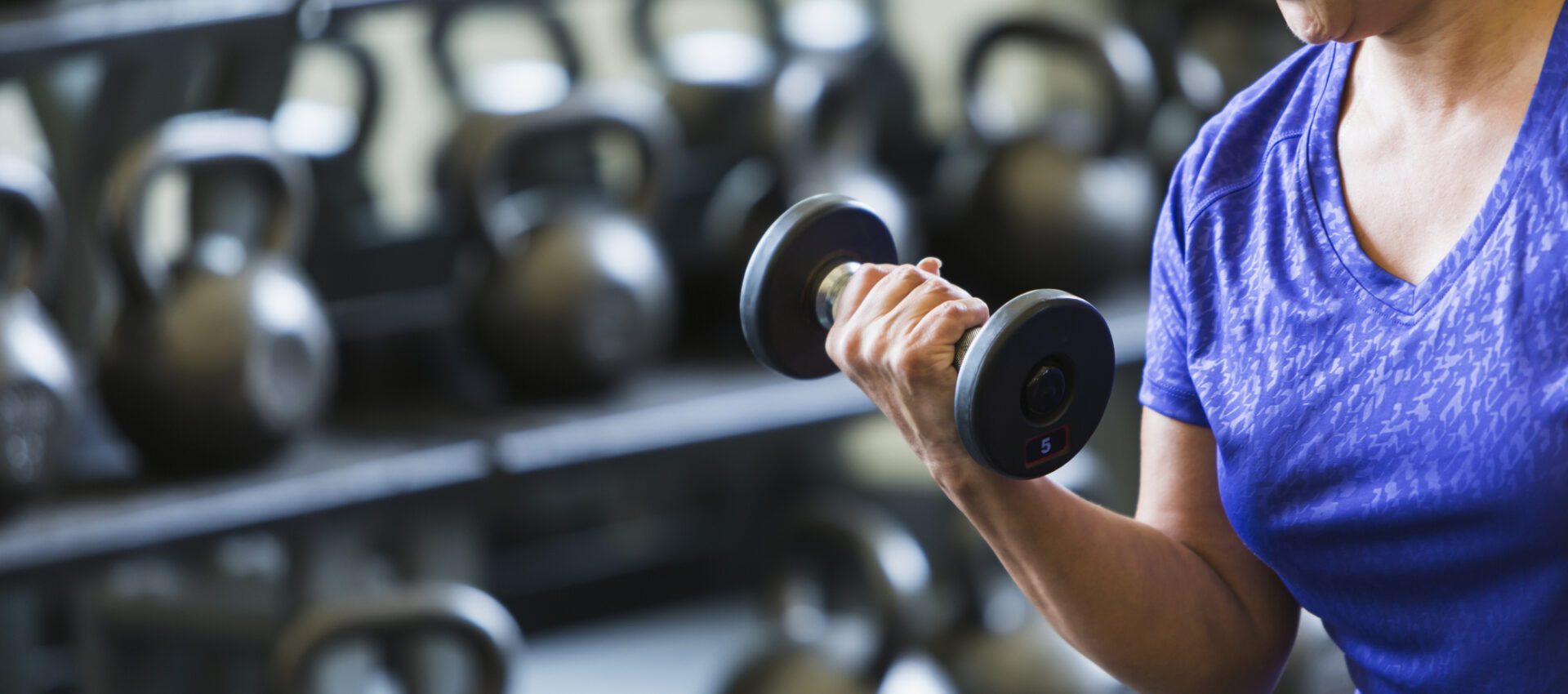
For years, we’ve been told that metabolism inevitably slows down with age—especially for women over 40. But recent research has flipped that narrative on its head. A groundbreaking study published in Science revealed that metabolic rates actually stay stable from ages 20 to 60. It’s only after your 60s that a noticeable decline in metabolism typically occurs. This finding challenges the widespread belief that a slower metabolism is to blame for weight gain in midlife.1
So if your metabolism isn’t slowing down as you age, what’s really going on? For women, the hormone fluctuations that come with menopause can make it harder to maintain muscle mass and manage weight. But here’s the empowering truth: You can take control. By focusing on what’s within your reach—like building lean muscle mass through resistance training—you can boost your metabolism, support your overall health, and age powerfully.
Lifting weights is one of the most effective ways to optimize your metabolism and set yourself up for lasting health.
How Resistance Training Boosts Your Metabolism
1. Resistance Training Increases Muscle Mass
Resistance training provides a powerful way to boost your metabolism while safeguarding your long-term health. As you build muscle through strength exercises, your resting metabolic rate (the energy your body uses at rest to maintain essential functions) gets a significant upgrade. This increased muscle mass improves metabolic flexibility, allowing your body to switch more efficiently between using carbohydrates and fat for energy.2, 3
Lifting weights is also your best defense against sarcopenia, the natural muscle loss that occurs as you age. Regular strength training is the only proven method to slow down this process and reduce its effects, helping you maintain muscle mass, strength, and a higher metabolic rate as you get older.4
2. Resistance Training Enhances Calorie Burning
Resistance training can help you burn calories more efficiently because the muscle you build requires energy to maintain itself. The more muscle you have, the higher your resting metabolic rate becomes, and the more calories you burn at rest.5, 6
Plus, after you’ve finished resistance training, your body experiences the afterburn effect. This keeps your metabolism revved up for hours after you’ve finished exercising, continuing to burn calories at an elevated rate. By incorporating resistance training into your routine, you’re setting yourself up for long-term metabolic success, making weight loss and maintaining a healthy weight more manageable.
3. Resistance Training Improves Insulin Sensitivity
During menopause, lower estrogen levels can decrease insulin sensitivity, making it harder for your cells to use glucose effectively. This can raise blood-sugar levels, slow your metabolism, and lead to weight gain. It can also change how your body processes and stores fat and carbohydrates, making weight loss harder.7
Lifting weights can help you improve your insulin response. Insulin is a hormone that shuttles glucose into your cells so they can use that blood sugar for energy. Resistance training makes cells more responsive to insulin by increasing the number and efficiency of glucose transporters in muscle cells. When these transporters are more effective, they can move more glucose from the bloodstream into cells for energy, reducing blood-sugar levels and decreasing the likelihood of glucose being stored as fat.8
By improving your body’s response to insulin, you’re lowering your chances of developing insulin resistance, can lead to type 2 diabetes and metabolic syndrome if left unchecked. Metabolic syndrome is a group of risk factors like high blood pressure, elevated blood sugar, extra belly fat, and unhealthy cholesterol levels, which can increase your risk of heart disease and stroke.9
4. Hormonal Balance
With declining estrogen during perimenopause, your body’s stress response becomes more sensitive, often leading to higher cortisol levels. Elevated cortisol can promote belly fat storage and muscle breakdown.10
Menopause can also affect thyroid function, with some women experiencing reduced thyroid activity (hypothyroidism) and others an increase (hyperthyroidism). Both impact your metabolism, altering how efficiently your body burns calories and regulates energy, affecting weight, energy levels, and overall health.11
Resistance training helps counter these hormonal shifts by optimizing hormone balance. Lifting heavy can increase levels of T3 (the active thyroid hormone that regulates metabolism) and improve your body’s stress response, giving your metabolism a boost that allows for better calorie burning and energy use.12, 13
Additionally, resistance training stimulates metabolism-enhancing hormones like testosterone and growth hormone, which tend to decline during menopause. These hormones are essential for muscle protein synthesis (building new muscle) and breaking down fat for energy, making your body a more efficient fat-burner.14
Each time you lift weights or use resistance bands, you’re supporting your body’s production and regulation of these hormones. The result? A more active metabolism, more stable energy, and a body that’s better at burning rather than storing fat.15
5. Enhanced Bone Density and Joint Health
Estrogen plays a crucial role in maintaining strong bones, but as estrogen levels drop during menopause, bone loss can accelerate. During this transition, women may lose up to 20% of their bone density, making bones more susceptible to fractures.16
This rapid loss of bone strength can lead to osteoporosis, a condition that makes bones porous and brittle. Even minor impacts or falls that were manageable before can now result in fractures.
Fragile bones also require extra energy for repair after minor injuries or microfractures, but this energy demand is more sporadic than steady and doesn’t significantly raise baseline metabolism like muscle tissue does. Instead, the risk of fractures can discourage physical activity, leading to muscle loss and a slower overall metabolism.17
Resistance training combats these effects by stimulating new bone growth and slowing bone loss, helping to counteract the natural decline in skeletal health. It also strengthens the muscles and tissues around joints, enhancing joint stability and reducing the risk of injury. Healthier joints make it easier to stay active and mobile, which allows you to perform more frequent, intense activities that build muscle and burn calories. This results in a higher metabolic rate and better overall metabolic health.18, 19
Lift Heavy, Live Better: Your At-Home Metabolism Makeover
Ready to rev up your metabolism and get all the benefits of resistance training? With the right tools and guidance, getting started is simple. My Resistance Training Cheat Sheet provides everything you need to kickstart your strength journey.
This handy guide typically includes a list of gym essentials to set up an effective workout space in your home. I’ve also included a structured eight-week workout plan to remove the guesswork from your training sessions and ensure you’re progressively challenging your muscles.
With each workout, you’ll also get a progress tracker to monitor your sets, reps, and weights. By following this plan and tracking your progress, you’ll be able to see your strength increase and feel your metabolism boost over time.
Get your FREE Resistance Training Cheat Sheet here.
References:
- Harvard Health: Surprising findings about metabolism and age
- Healthline: 14 Benefits of Strength Training, Backed by Science
- Shoemaker ME, Gillen ZM, Fukuda DH, Cramer JT. Metabolic Flexibility and Inflexibility: Pathology Underlying Metabolism Dysfunction. J Clin Med. 2023 Jul 3;12(13):4453. doi: 10.3390/jcm12134453. PMID: 37445488; PMCID: PMC10342527.
- UT Southwestern Medical Center: Strength training over 60 can help prevent sarcopenia
- Cleveland Clinic Health Essentials: What Is EPOC? (And Why It Matters)
- Verywell Fit: How Many Calories Does Muscle Really Burn?
- Women’s Health Network: How to Avoid Insulin Resistance
- Kolb H, Kempf K, Martin S. Insulin and aging – a disappointing relationship. Front Endocrinol (Lausanne). 2023 Oct 3;14:1261298. doi: 10.3389/fendo.2023.1261298. PMID: 37854186; PMCID: PMC10579801.
- Niemann MJ, Tucker LA, Bailey BW, Davidson LE. Strength Training and Insulin Resistance: The Mediating Role of Body Composition. J Diabetes Res. 2020 May 8;2020:7694825. doi: 10.1155/2020/7694825. PMID: 32455135; PMCID: PMC7235686.
- Woods NF, Mitchell ES, Smith-Dijulio K. Cortisol levels during the menopausal transition and early postmenopause: observations from the Seattle Midlife Women’s Health Study. Menopause. 2009 Jul-Aug;16(4):708-18. doi: 10.1097/gme.0b013e318198d6b2. PMID: 19322116; PMCID: PMC2749064.
- Healthline: Thyroid and Menopause: Is There a Connection?
- Harvard Health Publishing: Exercising to Relax
- DA Silva JMP, Silva GCE, DA Conceição RR, Laureano-Melo R, Giannocco G, Sato MA, Bentes CM, Simão R. Influence of Resistance Training Exercise Order on Acute Thyroid Hormone Responses. Int J Exerc Sci. 2022 May 1;15(2):760-770. PMID: 35992182; PMCID: PMC9365113.
- Kraemer WJ, Ratamess NA. Hormonal responses and adaptations to resistance exercise and training. Sports Med. 2005;35(4):339-61. doi: 10.2165/00007256-200535040-00004. PMID: 15831061.
- Feisty Menopause: 4 Reasons Why Menopausal Women Should Lift Heavy Sh*t
- Endocrine Society: Menopause and Bone Loss
- Karlamangla AS, Burnett-Bowie SM, Crandall CJ. Bone Health During the Menopause Transition and Beyond. Obstet Gynecol Clin North Am. 2018 Dec;45(4):695-708. doi: 10.1016/j.ogc.2018.07.012. Epub 2018 Oct 25. PMID: 30401551; PMCID: PMC6226267.
- Harvard Health: Strength training builds more than muscles
- Healthline: 5 Ways to Strengthen Your Joints
These statements have not been evaluated by the Food & Drug Administration. Products mentioned are not intended to diagnose, treat, cure, or prevent any disease. The views in this blog by JJ Virgin should never be used as a substitute for professional medical advice. Please work with a healthcare practitioner concerning any medical problem or concern.
The post 5 Ways Resistance Training Boosts Your Metabolism appeared first on JJ Virgin.
How Chronic Inflammation Affects Aging and What to Do About It 14 Dec 2024 10:00 PM (4 months ago)

Do you feel like you’re aging faster than you should? The culprit might be hiding within you—it’s called chronic inflammation, and it’s a slow-burning fire that can quietly impact your health and vitality every day.
Chronic inflammation often starts silently, without dramatic symptoms. It gradually erodes your well-being, setting the stage for serious health issues like heart disease, diabetes, and autoimmune disorders. Over time, this internal fire can also take a toll on your appearance and brain function.
Are fine lines appearing sooner than expected? Do you find yourself battling unexplained fatigue or brain fog? These common signs may signal that chronic inflammation is at work. The good news? You have the power to combat it! Let’s explore practical strategies to cool the flames and reclaim your health.
What Is Chronic Inflammation?
Inflammation can take on different forms. Acute inflammation is your body’s natural protective response, helping to heal injuries and fight infections. In contrast, chronic inflammation lingers over time, gradually weakening your body and contributing to long-term health issues.
Put another way: acute inflammation heals your body, while chronic inflammation harms you. This persistent immune response can lead to cellular damage that speeds up visible signs of aging like wrinkles and loss of skin elasticity. It can also put stress on your bones and joints and, over time, can compromise your organs and brain function. This may increase your risk for age-related diseases like heart disease, dementia, and certain cancers.1-4
The Link Between Chronic Inflammation and Aging
Chronic inflammation can accelerate aging at the cellular level by causing hidden damage inside your cells. This persistent inflammation releases harmful substances, including pro-inflammatory molecules and free radicals, which attack critical components of your cells, such as DNA, proteins, and the cell membrane. This cellular damage disrupts normal cell function, speeding up the aging process.5, 6
Over time, the toll of chronic inflammation can contribute to age-related health problems like heart disease, diabetes, osteoporosis, and memory loss. It doesn’t just harm individual cells; it impacts entire organs and systems, leading to a range of health issues. Even your skin, the body’s largest organ, can show early signs of aging—think wrinkles, reduced firmness, and other changes that appear sooner than expected.7, 8
How can you tell if chronic inflammation is affecting you? Look for persistent fatigue that lingers despite adequate rest, recurring joint pain, ongoing digestive issues, and frequent infections. Other subtle but significant indicators may include brain fog that makes it hard to concentrate, mood swings that seem out of character, or unexplained weight changes. Each of these symptoms could signal that chronic inflammation is quietly undermining your vitality.9, 10
Strategies to Combat Chronic Inflammation and Age Powerfully
Adopt an Anti-Inflammatory, Eat-Protein-First Diet
Focusing on anti-inflammatory foods and eating protein first can form a strong foundation for reducing inflammation and its effects on aging. Protein is vital for repairing and building tissues, supporting immune function, and producing enzymes and hormones essential for healthy aging. It also helps maintain muscle mass, which naturally declines with age, keeping you stronger and more resilient.
Incorporate high-fiber foods to help eliminate toxins that contribute to inflammation, along with healthy fats—like omega-3 fatty acids found in wild-caught fish—that actively combat inflammatory processes. This combination, what I call “eating by the plate,” creates a robust defense against inflammation.11-13
What you avoid is just as important as what you eat. Keep out pro-inflammatory foods like processed sugars, trans fats, and refined carbohydrates. 14 These troublemakers can fan the flames of inflammation and speed up the aging process.

Incorporate Resistance Training
Resistance training is a powerful tool against inflammation. Each workout improves your body’s insulin sensitivity, regulates stress hormones, and reduces chronic inflammation. Those benefits amplify with walking, which improves circulation, boosts cardiovascular health, keeps joints flexible, and supports a healthy weight.15, 16
Ready to start? My Resistance Training Cheat Sheet has all you need: essential home gym tips, an 8-week workout plan, and a progress tracker to record your reps, sets, and weight to see your progress firsthand. Get yours FREE here.
Manage Stress Effectively
Stress isn’t doing you any favors in the aging department. Chronic inflammation triggers the release of stress hormones like cortisol. When elevated for long periods, cortisol can increase inflammation. High cortisol levels also disrupt immune function, increase free-radical damage that can harm your cells and raise blood sugar—all factors that amplify inflammation.17 This creates a vicious cycle: more stress leads to more inflammation, which can worsen stress, keeping the cycle spinning and impacting long-term health.
Simple but effective stress-management techniques include meditation, deep-breathing exercises, and spending time in nature. Time spent outdoors, whether walking in the park or gardening, does wonders for stress relief.
These aren’t just feel-good activities but practical, science-backed strategies to fight inflammation and support healthy aging.
Prioritize Quality Sleep
Quality sleep is essential for regulating and reducing inflammation. When you’re sleep-deprived, your body produces more inflammatory molecules and stress hormones, fueling inflammation rather than calming it. This lack of rest disrupts your immune system and makes it harder to fight chronic inflammation, accelerating aging and increasing susceptibility to age-related conditions.18
Establish a consistent bedtime routine with calming activities like reading or a warm bath to signal it’s time to wind down. Creating a restful environment is also essential: keep your bedroom cool, dark, and quiet, with comfortable bedding, and consider blackout curtains if outside light is an issue.
One of the most impactful changes you can make is to limit screen time before bed; blue light from phones, tablets, and computers disrupts your natural sleep-wake cycle. Aim to put away devices at least an hour before bed to support better sleep.
If you have trouble falling or staying asleep, take a high-quality supplement that combines melatonin with other sleep-supporting nutrients.
Sleep&Glow offers innovative sleep products designed to enhance both sleep quality and beauty. Their popular Omnia pillow is crafted to help prevent sleep wrinkles and reduce morning puffiness, while their blankets, loungewear, and supplements each support different aspects of restful sleep. With a focus on ergonomic design and materials that promote better sleep, Sleep&Glow is committed to helping you sleep well and feel great. Shop Sleep&Glow and use code jjvirgin to get $20 off pillows and blankets.*
How ‘Healthy’ Foods Can Contribute to Inflammation
You already know that foods like sugar and damaged fats can fuel inflammation, but what if the “healthy” foods you eat are also part of the problem? Some of these so-called nutritious choices may quietly contribute to inflammation and hold you back from feeling your best. They may also be causing symptoms like gas, bloating, fatigue, headaches, skin breakouts, cravings, and stubborn belly fat.
If you feel like you’re eating well but still struggling with these issues, you might be dealing with hidden food sensitivities. I’ve identified the top 7 culprits—what I call Hi-FI (High Food Intolerance) foods—that are most likely to trigger these problems. In The Ditch List: 7 Foods Harming Your Health, I’ll help you pinpoint these offenders and guide you toward smarter, equally satisfying swaps to help you feel better fast.
Get your FREE copy of The Ditch List: 7 Foods Harming Your Health here.
References:
- Pahwa R, Goyal A, Jialal I. Chronic Inflammation. [Updated 2023 Aug 7]. In: StatPearls [Internet]. Treasure Island (FL): StatPearls Publishing; 2024 Jan-. Available from: https://www.ncbi.nlm.nih.gov/books/NBK493173/
- Salminen A, Kaarniranta K, Kauppinen A. Photoaging: UV radiation-induced inflammation and immunosuppression accelerate the aging process in the skin. Inflamm Res. 2022 Aug;71(7-8):817-831. doi: 10.1007/s00011-022-01598-8. Epub 2022 Jun 24. PMID: 35748903; PMCID: PMC9307547.
- Howcroft TK, Campisi J, Louis GB, Smith MT, Wise B, Wyss-Coray T, Augustine AD, McElhaney JE, Kohanski R, Sierra F. The role of inflammation in age-related disease. Aging (Albany NY). 2013 Jan;5(1):84-93. doi: 10.18632/aging.100531. PMID: 23474627; PMCID: PMC3616233.
- Agrawal R, Hu A, Bollag WB. The Skin and Inflamm-Aging. Biology (Basel). 2023 Nov 2;12(11):1396. doi: 10.3390/biology12111396. PMID: 37997995; PMCID: PMC10669244.
- Khansari N, Shakiba Y, Mahmoudi M. Chronic inflammation and oxidative stress as a major cause of age-related diseases and cancer. Recent Pat Inflamm Allergy Drug Discov. 2009 Jan;3(1):73-80. doi: 10.2174/187221309787158371. PMID: 19149749.
- Ferrucci L, Fabbri E. Inflammageing: chronic inflammation in ageing, cardiovascular disease, and frailty. Nat Rev Cardiol. 2018 Sep;15(9):505-522. doi: 10.1038/s41569-018-0064-2. PMID: 30065258; PMCID: PMC6146930.
- Weyand CM, Goronzy JJ. Aging of the Immune System. Mechanisms and Therapeutic Targets. Ann Am Thorac Soc. 2016 Dec;13 Suppl 5(Suppl 5):S422-S428. doi: 10.1513/AnnalsATS.201602-095AW. PMID: 28005419; PMCID: PMC5291468.
- Pająk J, Nowicka D, Szepietowski JC. Inflammaging and Immunosenescence as Part of Skin Aging-A Narrative Review. Int J Mol Sci. 2023 Apr 24;24(9):7784. doi: 10.3390/ijms24097784. PMID: 37175491; PMCID: PMC10178737.
- St. Vincent’s Medical Center: 8 Surprising Signs of Chronic Inflammation
- WebMD: Signs of Chronic Inflammation You May Not Expect
- Healthline: 9 Important Functions of Protein in Your Body
- Shivakoti R, Biggs ML, Djoussé L, Durda PJ, Kizer JR, Psaty B, Reiner AP, Tracy RP, Siscovick D, Mukamal KJ. Intake and Sources of Dietary Fiber, Inflammation, and Cardiovascular Disease in Older US Adults. JAMA Netw Open. 2022 Mar 1;5(3):e225012. doi: 10.1001/jamanetworkopen.2022.5012. PMID: 35357453; PMCID: PMC8972036.
- Calder PC. Omega-3 fatty acids and inflammatory processes. Nutrients. 2010 Mar;2(3):355-374. doi: 10.3390/nu2030355. Epub 2010 Mar 18. PMID: 22254027; PMCID: PMC3257651.
- Cleveland Clinic Health Essentials: 5 Types of Foods That Cause Inflammation
- Effting PS, Thirupathi A, Müller AP, Pereira BC, Sepa-Kishi DM, Marqueze LFB, Vasconcellos FTF, Nesi RT, Pereira TCB, Kist LW, Bogo MR, Ceddia RB, Pinho RA. Resistance Exercise Training Improves Metabolic and Inflammatory Control in Adipose and Muscle Tissues in Mice Fed a High-Fat Diet. Nutrients. 2022 May 24;14(11):2179. doi: 10.3390/nu14112179. PMID: 35683979; PMCID: PMC9182921.
- Mayo Clinic: Walking: Trim your waistline, improve your health
- Hannibal KE, Bishop MD. Chronic stress, cortisol dysfunction, and pain: a psychoneuroendocrine rationale for stress management in pain rehabilitation. Phys Ther. 2014 Dec;94(12):1816-25. doi: 10.2522/ptj.20130597. Epub 2014 Jul 17. PMID: 25035267; PMCID: PMC4263906.
- Mullington JM, Simpson NS, Meier-Ewert HK, Haack M. Sleep loss and inflammation. Best Pract Res Clin Endocrinol Metab. 2010 Oct;24(5):775-84. doi: 10.1016/j.beem.2010.08.014. PMID: 21112025; PMCID: PMC3548567.
These statements have not been evaluated by the Food & Drug Administration. Products mentioned are not intended to diagnose, treat, cure, or prevent any disease. The views in this blog by JJ Virgin should never be used as a substitute for professional medical advice. Please work with a healthcare practitioner concerning any medical problem or concern.
*I couldn’t make it without supportive relationships, and I bet you feel the same! That’s why my team and I offer you products and services we believe in. If you happen to purchase something I recommend here, I may receive some kind of compensation. However, I only bring you partners whose content and core values will serve you with the same commitment to excellence my team and I strive for every day. Please be in touch with any concerns.
The post How Chronic Inflammation Affects Aging and What to Do About It appeared first on JJ Virgin.
Healthy Meal Prep Recipe Roundup 11 Dec 2024 11:11 AM (4 months ago)

In today’s busy world, it’s easy to let great nutrition fall to the bottom of your to-do list. But here’s the thing: meal prep actually saves you time, in the long run. Further, meal prep helps you create a routine that reduces stress and ensures you are fueling your body with the right nutrients.
PRO TIP: You might want to bookmark this blog and save it to have handy for the next few weeks (or more), to support your health goals!
Imagine opening your fridge to find delicious, ready-to-eat meals, and all of those meals align perfectly with your health goals! Whether you’re racing out in the morning, squeezing in a quick lunch between meetings, or end up too tired to cook after a long day, having high-protein meals prepped and waiting for you makes staying on track easier than ever.
I’ve rounded up some of my favorite easy recipes to inspire fun meal prep and empower you with easy make-ahead meals. But first, a few tips to get you started.
My Best Tips for Easy Meal Prep
Some of my favorite meal-prep strategies include:
- Chop vegetables in advance to save time during the week.
- Freeze pre-portioned proteins like chicken breast or beef for quick cooking.
- Batch cook staple items (like roasted veggies or quinoa) and store them in the fridge for easy meals.
- Make large batches of soups or stews and freeze them in individual portions. (Try a silicone freezer tray for soup to make it simple.)
- Use airtight containers to store prepped ingredients and keep them fresh longer. Try to use glass with lids that have a silicone or rubber seal.
- Prep smoothie ingredients by portioning fruit, greens, and protein powder in advance. You can put the dry ingredients in a separate container and blend with liquid when you’re ready.
- Stock up on frozen fruits and veggies to save time and enjoy fresh-tasting produce that stays good for weeks or months.
- Pre-cook meats like grilled chicken or ground turkey for various weekly dishes. It takes the same amount of time to bake one chicken breast as it does a whole sheet pan of chicken.
- Label and date all prepped items to avoid waste and ensure freshness. We’ve all wondered what that mystery container is in the back of the freezer!
Breakfast Recipes
Loaded Smoothies

A loaded smoothie is my go-to for a quick, filling meal that’s perfect for hectic mornings or a speedy lunch. With the trifecta of protein, fat, and fiber, it’ll keep you satisfied and energized for hours. Every one of these smoothies is protein-powered. And these make-ahead, time-saving Almond-Cacao Smoothie Balls “bomb” your smoothie with an extra 7g of protein, 7g of fiber, and healthy fats whenever you want a boost.

This Berry Cobbler Protein Shake is so good you’ll swear it was dessert!
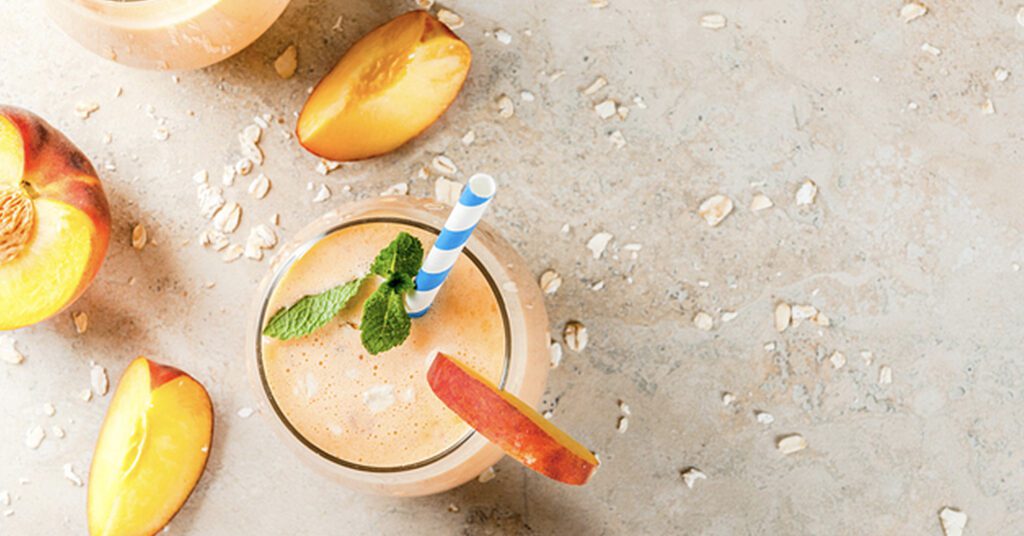
You’ll be sipping summer in a glass with this Peaches & Cream Smoothie. This is high in vitamin C and antioxidants from peaches. Plus it gives a boost of fiber from oats or chia seeds! This creamy, guilt-free treat lets you indulge in the flavors of summer all year round.
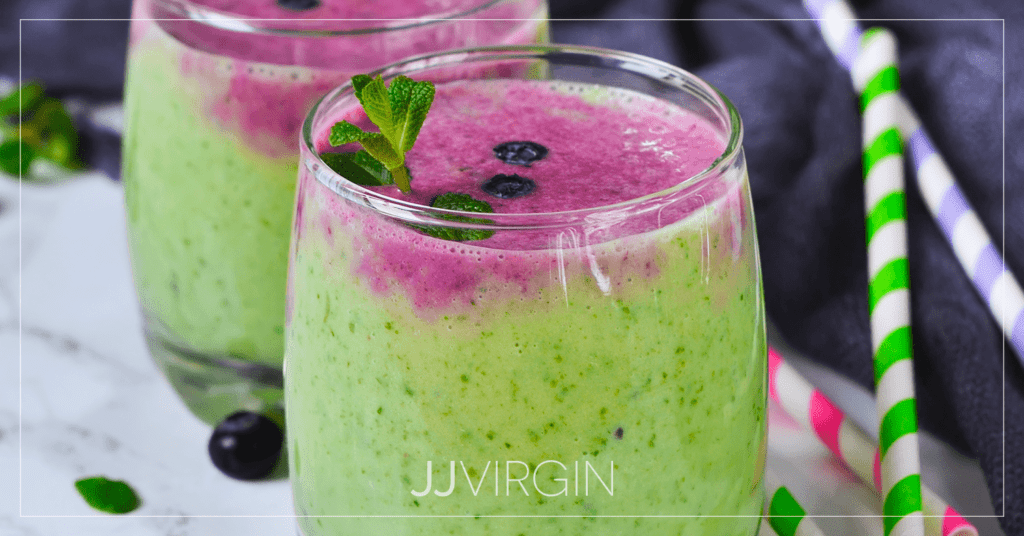
This yummy Matcha Blueberry Smoothie has layers of green tea and blueberry, plus plenty of detoxifying greens, fiber, vegan protein, and healthy fats from avocado.
Overnight Oats
Overnight oats are the ultimate hassle-free breakfast, ready and waiting for you when you wake up. Simply combine ingredients in a jar before bed. Then, let the magic happen while you sleep. In the morning, you’ll have a creamy, protein-rich breakfast that’s not only delicious but also perfectly customizable to your tastes.
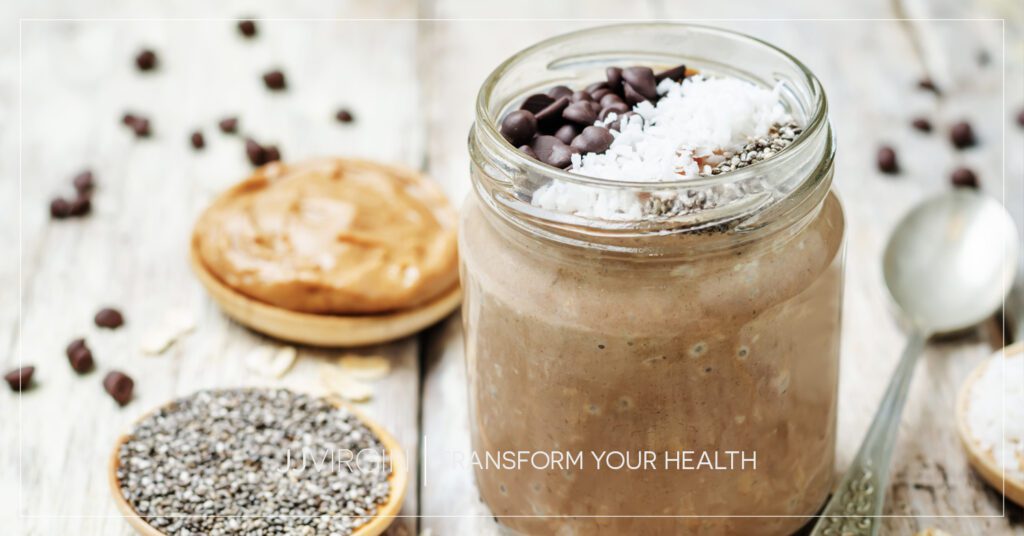
These Oatmeal Cookie Overnight Oats combine gluten-free oats, chia seeds, and almond butter! It also has the indulgent flavors of dark chocolate and cinnamon for a guilt-free sweet treat to start your day.

These protein-rich Cinnamon Almond Overnight Oats combine blood sugar-balancing cinnamon with nutritious almond butter, oats, and flaxseeds.
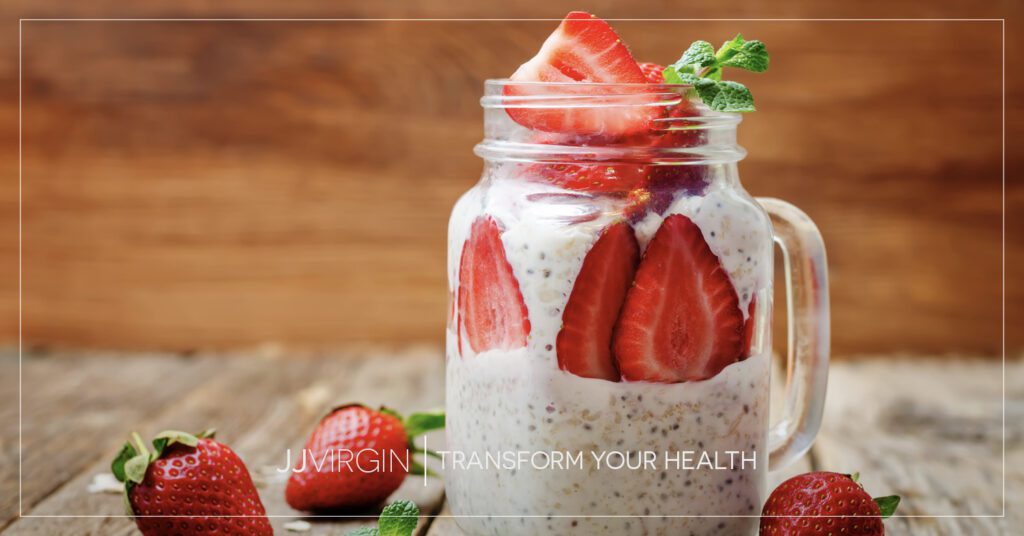
Strawberry shortcake in a jar: These Strawberries and Cream Overnight Oats capture the essence of the beloved dessert.

Autumn-inspired Butternut Pecan Overnight Oats pack an impressive 32g of protein and 19g of fiber.
Other Easy, Convenient Breakfast Ideas
Not in a smoothie mood? Start your day right with these quick, high-protein breakfast options! They’re also healthy, convenient, and give you the nutrients to power through your morning.
These irresistible Sweet Potato Waffles topped with Maple Almond Butter & Bacon have a perfect balance of flavors and textures along with 31g protein and 8g fiber.

These Cauliflower Breakfast Pizzas pair a crispy cauliflower crust with homemade chicken sausage, creamy butternut squash puree, and an array of colorful toppings. This delivers 36g protein and 11g fiber to fuel your body for the day ahead.

Kickstart your morning with our hearty and flavorful Savory Quinoa Breakfast Bowl, with 45g of protein per serving.
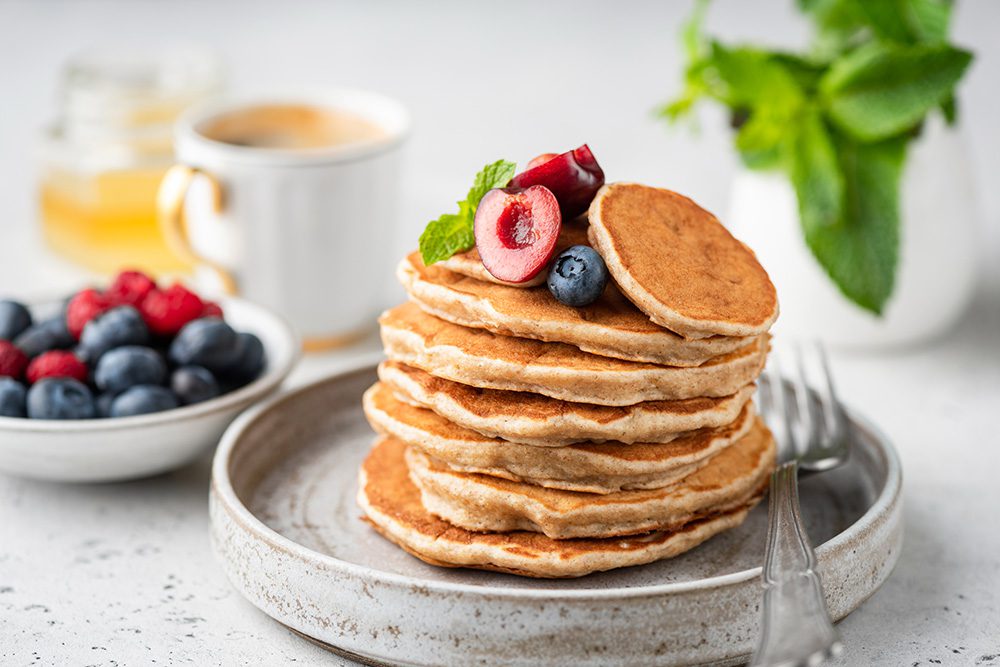
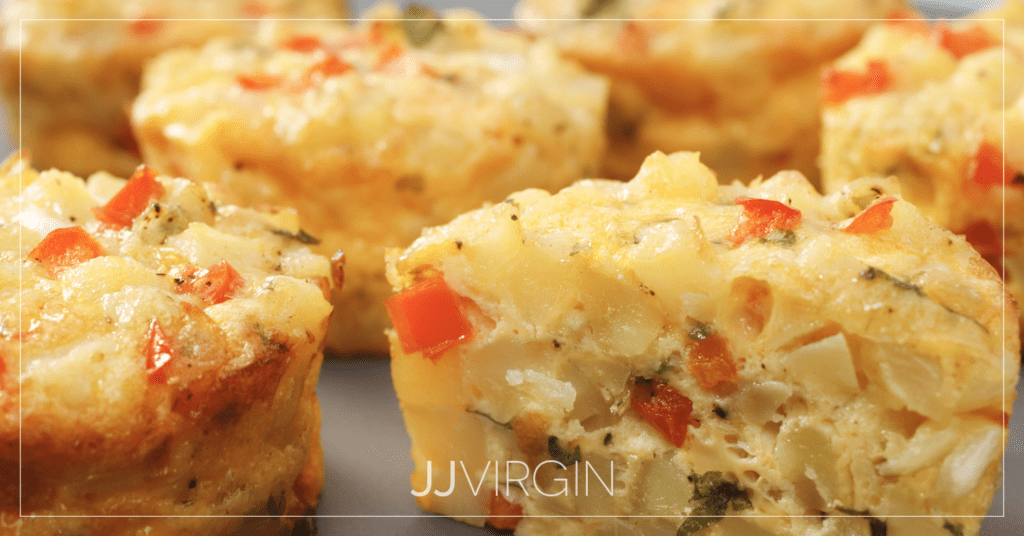
These Vanilla Quinoa Breakfast Cakes have a delightfully fluffy texture and unlike traditional pancakes, these offer 25g protein and 11g fiber per serving. Enjoy with a couple strips of nitrate-free bacon to boost your protein over 30 grams for the whole meal, or try one of our Individual Breakfast Frittatas!
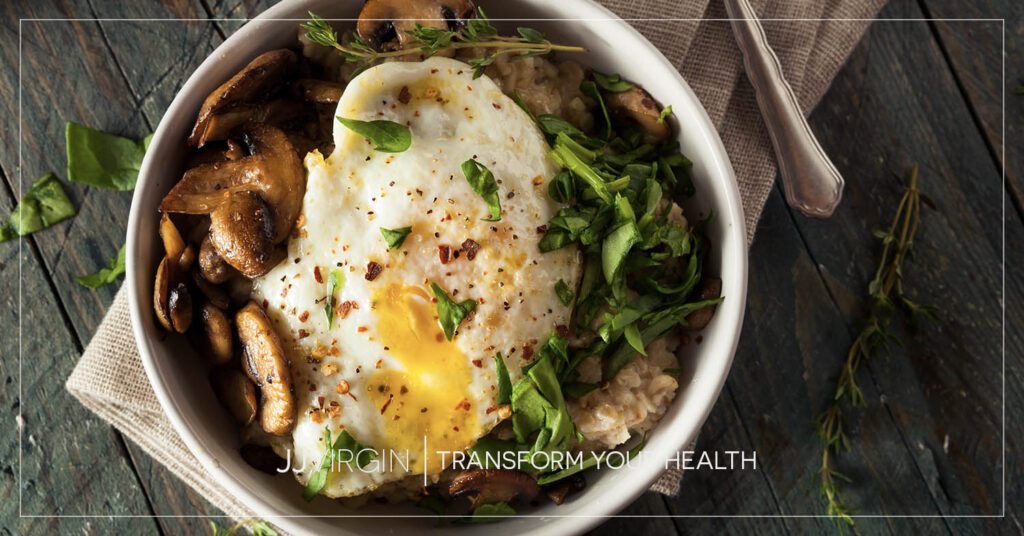
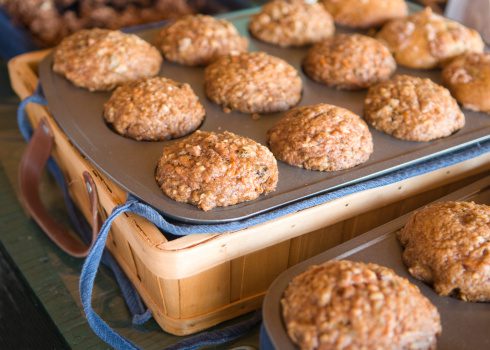
These Savory Bone Broth & Veggie Steel Cut Oats blend savory bone broth, mushrooms, spinach, and an optional egg. Pair them with a Sweet Potato Chai Oat Muffin for a total of 39g protein and 10g fiber.
Lunch and Dinner Recipes
Wraps
Wraps are the ultimate solution for a fast, filling, and portable meal that’s high in protein. Prep these handheld delights in advance and you’ll have a hearty meal in minutes.
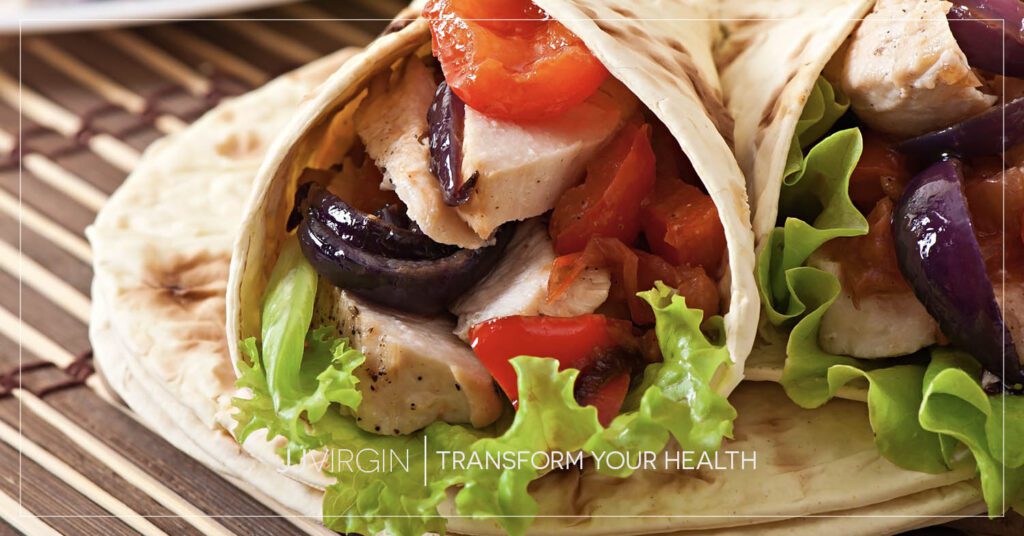
Can’t decide between a wrap and salad? Have both! This Chicken Caesar Salad Wrap packs a 28g of protein and 5g of fiber. It combines tender chicken, crisp romaine, and zesty Caesar-inspired dressing, all wrapped up in a gluten-free brown rice tortilla.
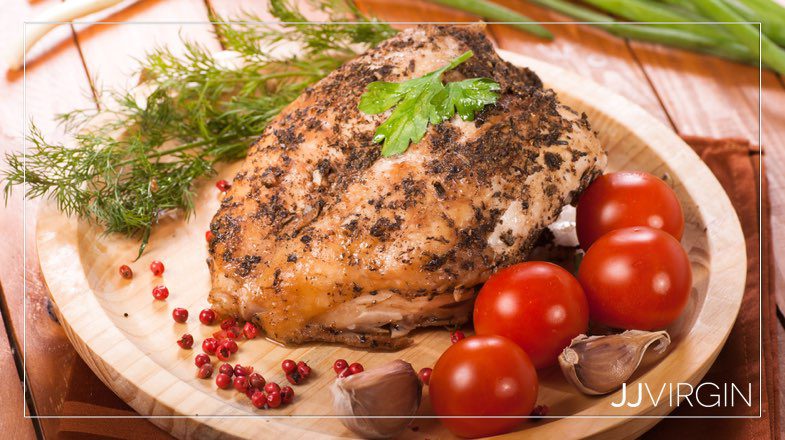
These fast, filling Grilled Pesto Chicken Wraps pair juicy grilled chicken with fresh pesto, nutritious kale, and tangy sun-dried tomatoes.

Bring the flavors of Argentina right to your kitchen with these Flank Steak and Vegetable Wraps with Chimichurri Sauce. This meal gets you 37g of protein and 4g of fiber in every delicious serving.
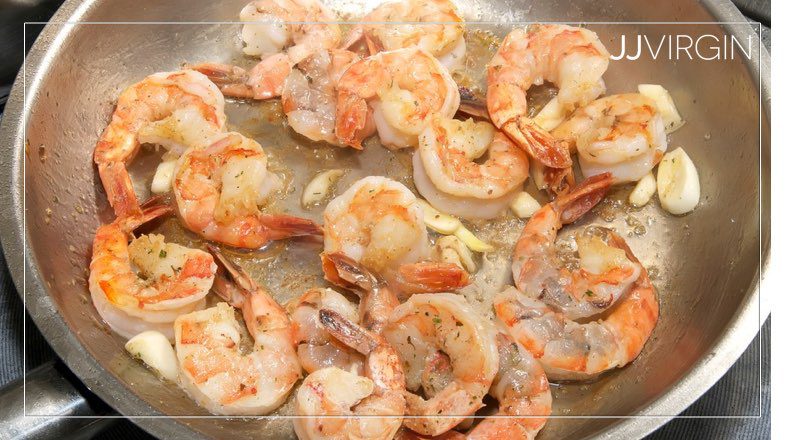
This Tangy Lime Shrimp & Avocado Wrap features flavorful shrimp zipped with lime. And it’s complemented by creamy avocado and fresh veggies, all wrapped in a gluten-free brown rice tortilla.
Salads
Banish the idea that salads are wimpy or boring! These high-protein salads are hearty meals that satisfy even the most voracious appetites.
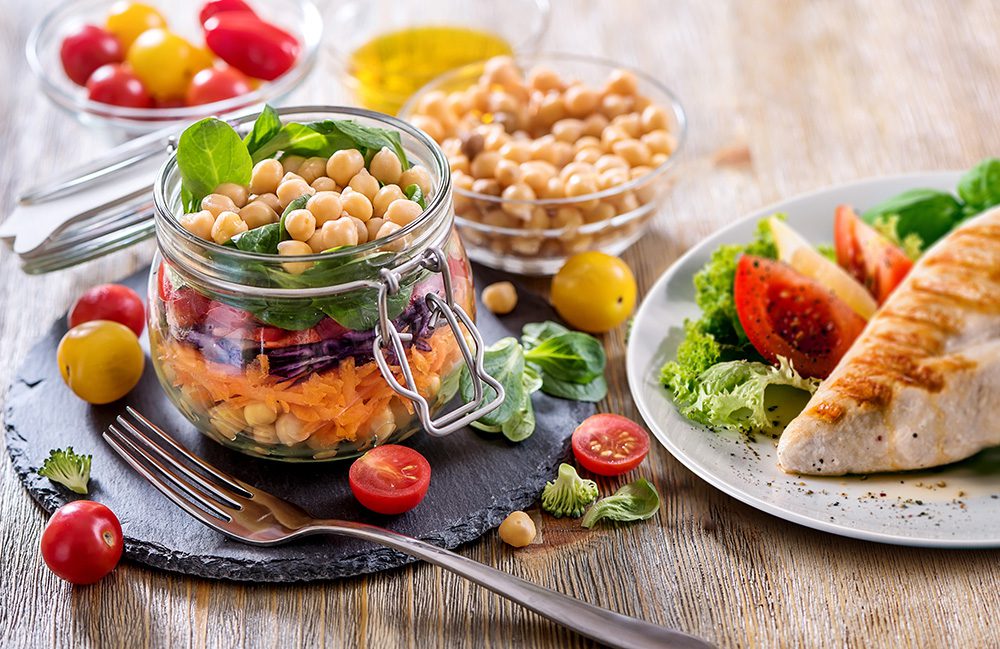
Bursting with bright Meyer lemon and fresh herbs, these easy-to-make and store Meyer Lemon Chicken Salad Jars are a flavor explosion and protein powerhouse. Every delicious serving packs 36g of protein and 11g of fiber.

Zesty peperoncini and tender grilled chicken? Yes! Make this hearty Grilled Chicken & Peperoncini Salad a Mediterranean-inspired feast that’s as satisfying as it is flavorful. And you’ll get 39g of protein and 6g of fiber in every serving.
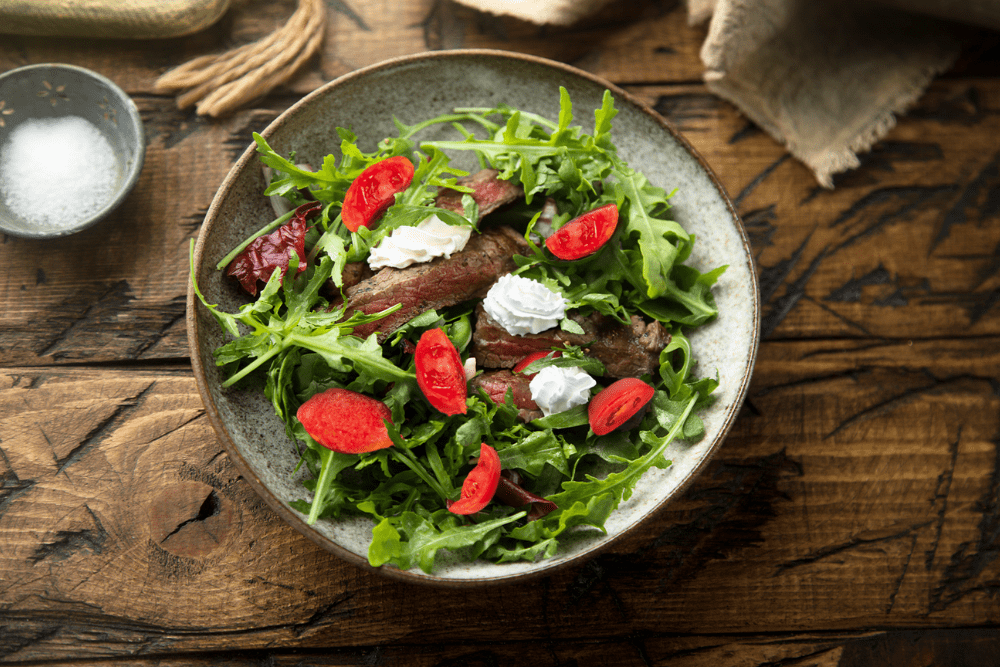
This Strip Steak With Lemony Coconut Cream & Arugula Salad elevates home dining with its perfect blend of juicy steak, tangy coconut cream, and peppery arugula. You’ll get 33g of protein in every serving!

This Grilled Chicken over Cucumber and Green Papaya Salad combines succulent grilled chicken with the refreshing crunch of green papaya and cucumber! All tossed in a zesty Thai-inspired dressing. It brings the vibrant flavors of Southeast Asia (and 31g of protein) to your plate.
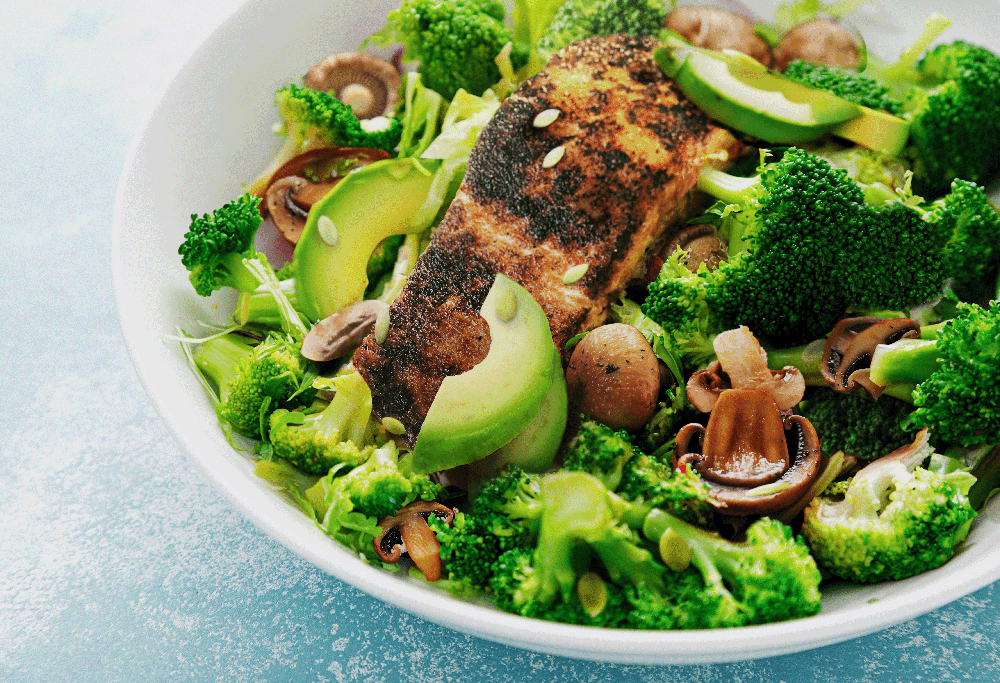
Indulge in a nutritious feast with this Blackened Salmon Over Sautéed Mushroom and Broccoli Salad, featuring omega-3-rich salmon, 42g of protein, and 7g of fiber from a vibrant medley of veggies.
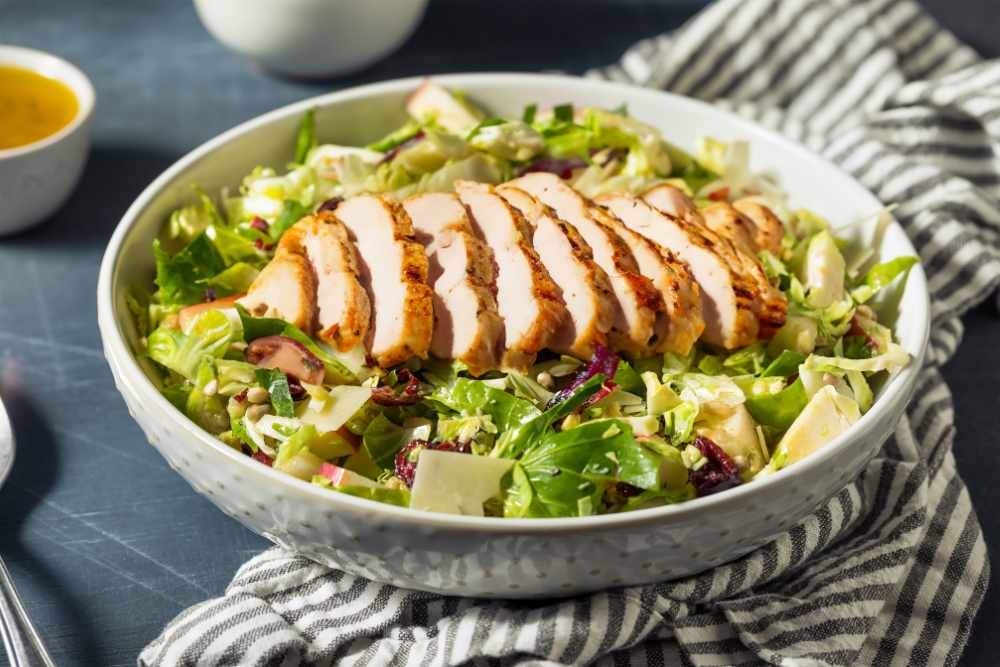
This Grilled Chicken Salad with Apple, Kale, and Brussels Sprouts comes loaded with an array of vibrant, health-boosting veggies—plus 63g of protein and 6g of fiber in every serving.

Vibrant and zesty, this Citrus Shrimp Salad is a refreshing symphony of flavors, featuring succulent seafood, crisp vegetables, and a tangy citrus dressing—along with 31g of protein and 7g of fiber.
Stews, Slow Cooker Recipes
Discover the ultimate convenience and comfort with these high-protein slow cooker stews. These hearty one-pot wonders satisfy your hunger and nourish your body with minimal effort.

This Three-Bean Turkey Chili is a classic comfort-food twist that swaps traditional beef for succulent ground turkey. It also features a trio of beans for depth and texture, plus 35g protein and 14g fiber in every serving.
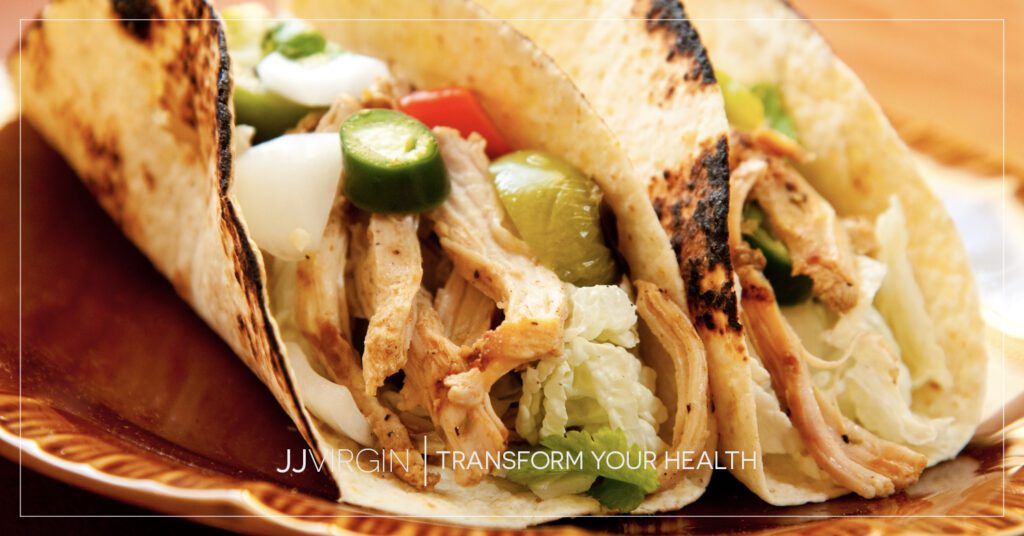
These Slow Cooker Shredded Chicken Tacos with Peppers and Lime are just right for a fuss-free family dinner or a cozy night curled up on the couch.

This nearly effortless Healthy Slow Cooker Lemon Thyme Chicken combines convenience with incredible flavor, infusing tender chicken thighs with bright citrus and aromatic herbs—and an impressive 51g of protein per serving.
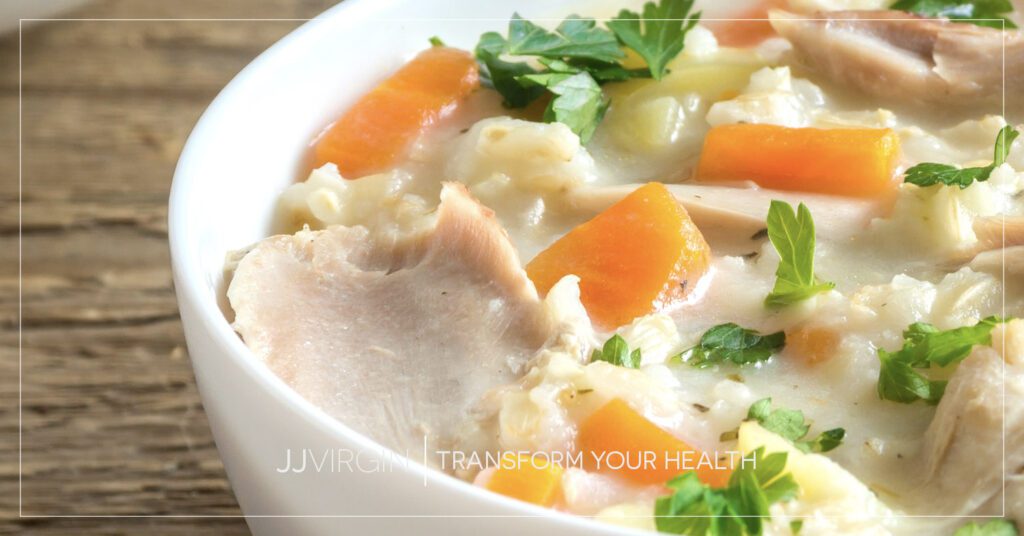
This high-protein Crockpot Chicken & Cauliflower Rice Stew combines hearty chicken thighs with a medley of veggies and aromatic herbs for a comforting, nutrient-rich meal, all with just 10 minutes of prep time!

Craving a trip to the bustling markets of Marrakech? We’ve captured the flavors in this Moroccan Braised Grass-Fed Beef Stew, which pairs tender beef with aromatic spices, hearty vegetables, and a robust 35g of protein and 6g of fiber in every serving.
Sides
Say goodbye to bland, uninspired vegetable sides and hello to these upgraded, flavor-packed dishes that will have everyone reaching for seconds.
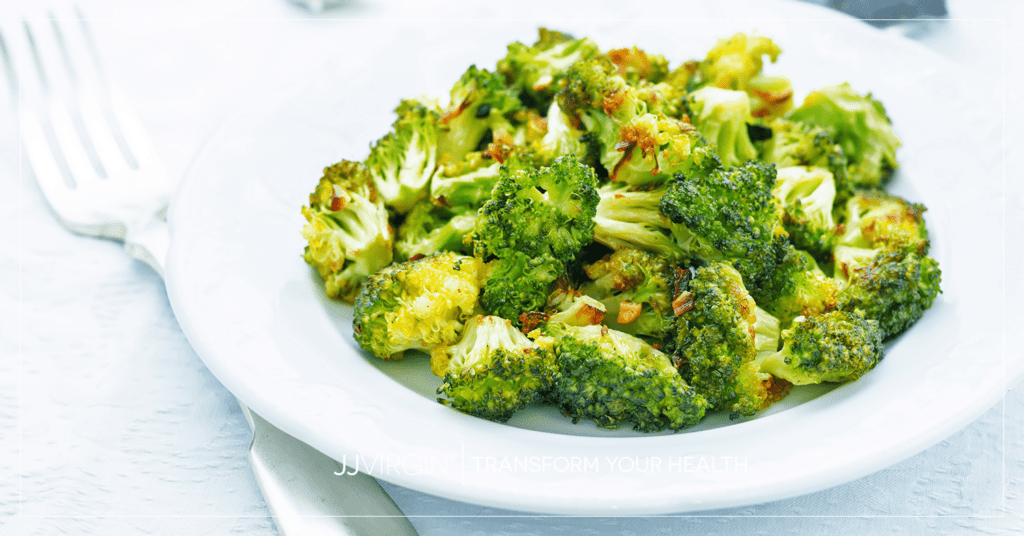
Transform ordinary broccoli into a flavor sensation with this Paleo Steamed Broccoli with Garlic Oil Drizzle. This simple yet elegant side dish packs serious flavor with 4g of protein and 5g of fiber per serving.

This Braised Kale transforms the nutritional powerhouse into a tender, flavorful side dish with 7g of protein and 3g of fiber in every serving.
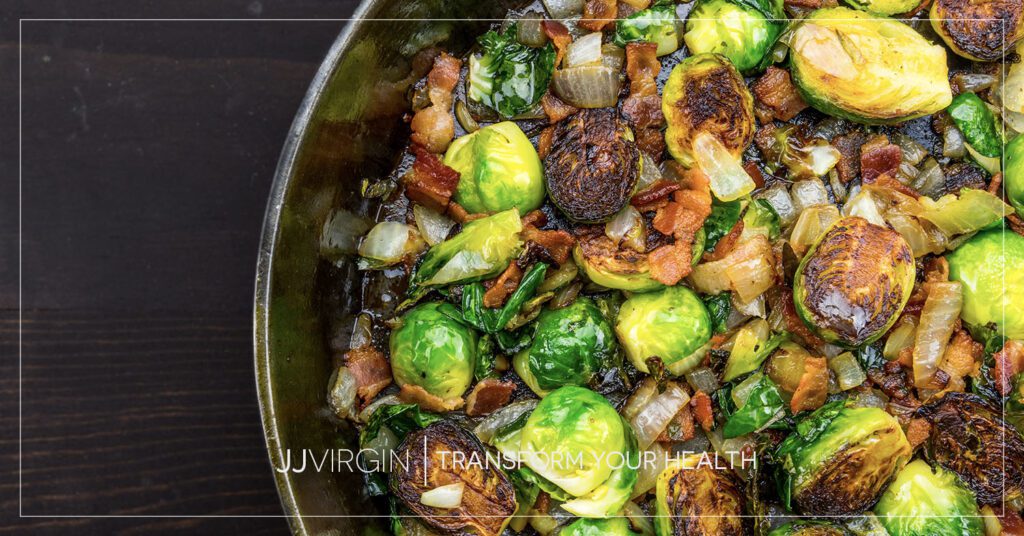
Because bacon makes everything better, these Roasted Brussels Sprouts with Bacon are an irresistible side dish that’ll convert even the most stubborn veggie skeptics. Crispy, savory, and slightly sweet, every serving delivers 15g of protein and 5g of fiber.
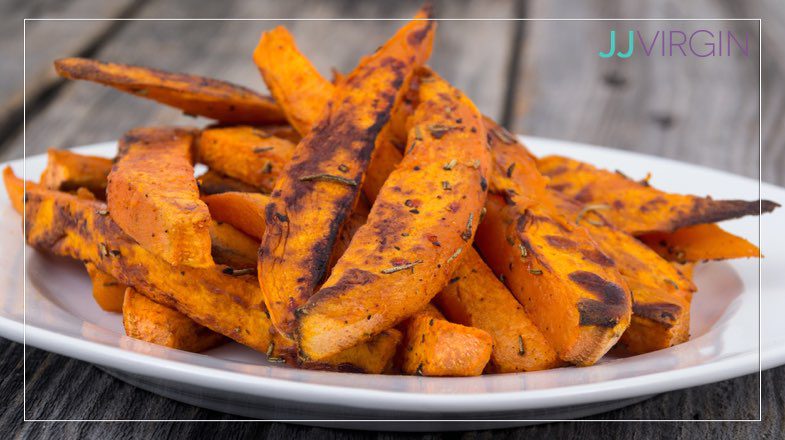
These Spiced Sweet Potato Fries offer a healthy, flavorful twist on a classic favorite that both kids and adults will love. With a perfect balance of sweet and spicy, these crispy fries pack 4g of fiber and 2g of protein per serving, making them a guilt-free, craving-satisfying indulgence.
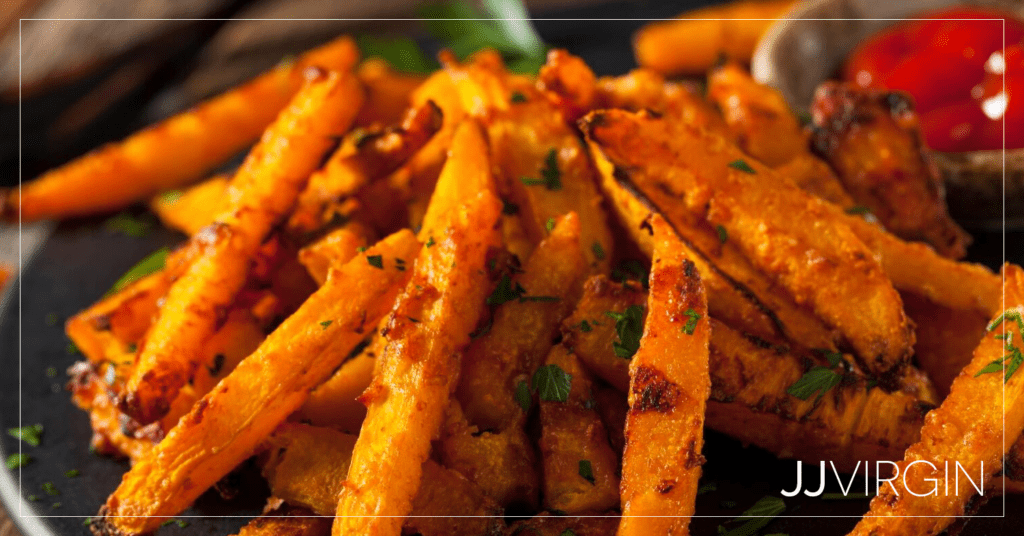
These Butternut Squash Fries offer a delicious, nutritious spin on traditional fries. Crispy on the outside and tender on the inside, they’re satisfying and nourishing, thanks to 5g of fiber and 2g of protein.
The Ultimate Protein-Fueled, Convenient, Quick Meal Replacement
Loaded smoothies are the ultimate convenience food, offering easy prep and quick results for busy, on-the-go women. Whether you’re juggling work deadlines, family responsibilities, or trying to squeeze in a workout, these nutrient-packed meal replacements provide a perfect solution for nourishing your body without slowing down your hectic schedule.
My Eat Protein First Loaded Smoothie Cookbook features over 60 delicious recipes that help you effortlessly meet your daily protein goals, ensuring you get the nutrients you need to thrive—especially considering your protein requirements increase with age. We’ve designed each recipe to deliver at least 30 grams of lean, clean protein, along with healthy fats and fiber, making it simple to boost your energy, support muscle maintenance, and enhance overall wellness.
Get your FREE Eat Protein First Loaded Smoothie Cookbook here.
These statements have not been evaluated by the Food & Drug Administration. Products mentioned are not intended to diagnose, treat, cure, or prevent any disease. The views in this blog by JJ Virgin should never be used as a substitute for professional medical advice. Please work with a healthcare practitioner concerning any medical problem or concern.
The post Healthy Meal Prep Recipe Roundup appeared first on JJ Virgin.
How Menopause Affects Your Sleep 7 Dec 2024 10:00 PM (4 months ago)

Menopause brings numerous changes to your body, from hot flashes and night sweats to mood swings and weight fluctuations. Among these shifts, sleep disturbances can be particularly frustrating. As your hormone levels fluctuate, you might toss and turn at night, struggle to fall asleep, or wake up multiple times a night. These sleep issues can worsen other menopausal symptoms, leaving you feeling exhausted and irritable during the day.1, 2
You’re not alone in facing these challenges. Sleep problems affect 40-60% of women during menopause, with research indicating an increased likelihood of sleep disturbances during this transition.3
The Impact of Sleep Issues During Menopause
Sleep issues during menopause primarily stem from hormonal fluctuations, particularly a drop in estrogen. This hormone plays a key role in regulating body temperature, promoting sleep-related chemicals in the brain, and keeping throat muscles toned to maintain open airways. Lower estrogen levels can lead to insomnia, sleep apnea, and restless leg syndrome, which can all make it harder to get restful sleep.4, 5
These hormone-driven sleep disturbances can create a domino effect on your health. Poor sleep increases the risk of serious conditions like heart disease, diabetes, and obesity, while also exacerbating mood disorders such as depression and anxiety. Additionally, disrupted sleep can further impair hormonal balance, leading to heightened stress, increased hunger, and weight gain. Common menopausal symptoms like night sweats and hot flashes can add to the struggle, creating a challenging cycle.6-9
Altogether, it may feel like a vicious cycle with no way out, but with the right strategies, you can cultivate great sleep during this transition.
5 Ways to Improve Sleep During Menopause
1. Eat by the Plate
Embrace the trifecta of protein, healthy fats, and fiber—what I call eating by the plate. Aim for 30-50g of protein per meal, as it helps boost the production of sleep-promoting hormones like serotonin and melatonin, essential for a healthy sleep cycle.
Healthy fats, fiber, and slow-digesting carbs further support restful sleep by balancing blood sugar and promoting neurotransmitter production.10-13
Consider phytoestrogen-rich foods as well, which can mimic the effects of estrogen in your body and alleviate menopausal symptoms. Great options include adding ground flaxseed to your loaded smoothies (try my Hot Flash-Halting Protein Shake) and incorporating garbanzo beans in recipes like this Chickpea Falafel Salad with Tahini Dressing.14

2. Maintain Regular Exercise
Regular exercise is a powerful tool for improving sleep quality during menopause. It helps regulate your natural sleep-wake cycle and combats stress and anxiety by releasing feel-good endorphins. Research shows that exercise can significantly reduce the severity of insomnia and alleviate sleep problems in menopausal women.
Resistance training, in particular, promotes deeper, more restorative sleep. Pairing consistent strength exercises with an after-dinner walk can aid digestion and relaxation, setting the stage for a good night’s sleep.15, 16
Timing is key for maximizing the sleep benefits of exercise. Just as you should close the kitchen three hours before bedtime, aim to avoid intense workouts within two to three hours of sleep as well to prevent difficulty falling asleep.
3. Optimize Your Sleep Environment
Creating an ideal sleep environment is key to improving your sleep quality during menopause. Start by maintaining a cool bedroom temperature (65°-68°F), ensuring complete darkness, and using comfortable, breathable bedding. Establishing a consistent sleep schedule and developing a calming pre-sleep routine can signal your body that it’s time to wind down.
Sleep&Glow creates cutting-edge sleep products that boost both sleep quality and beauty. Their signature Omnia pillow helps prevent sleep wrinkles and reduces morning puffiness, while their blankets, loungewear, and supplements support different aspects of restful sleep. By blending ergonomic design with sleep-enhancing materials, Sleep&Glow is dedicated to improving sleep and overall wellness. Shop Sleep&Glow and use code jjvirgin for $20 off pillows and blankets.*
Consider incorporating sleep-support supplements into your nighttime routine. Melatonin, a hormone naturally produced by your body, can help you fall asleep faster and enhance sleep quality. For added benefits, look for high-quality supplements that combine melatonin with other calming nutrients.
Finally, limit screen time for at least an hour before bed to avoid blue light interference with your sleep-wake cycle. If you must use screens, blue-blocking glasses like these True Dark blue light glasses can be a helpful tool to reduce your exposure at night. (Get 10% OFF with code JJ10.)*
4. Manage Stress
Stress can be a major roadblock to a good night’s sleep, especially during menopause. When stressed, your body releases cortisol, the “fight or flight” hormone, which keeps you alert and makes it hard to wind down. This heightened alertness can lead to racing thoughts, muscle tension, and restlessness, making falling asleep feel impossible. Plus, stress can exacerbate other menopause symptoms like hot flashes, mood swings, and weight gain.19, 20
To combat this, build a toolkit of stress-management techniques. Daily meditation or deep breathing exercises can promote relaxation and prepare your body for sleep. Research shows that meditation can help alleviate symptoms like mood swings and irritability linked to hormonal changes.21 Personally, I’ve found Dr. Joe Dispenza’s meditations to be a lifeline for better sleep. Additionally, keeping a gratitude journal can help shift your focus to the positive, reducing anxiety and fostering a calmer mindset.
5. Work With a Functional-Medicine Doctor
You don’t have to tackle sleep issues during menopause alone. A functional-medicine doctor can provide personalized solutions tailored to your needs. They may recommend hormone therapies, such as progesterone, to help regulate sleep and alleviate other menopausal symptoms.
Functional medicine takes a holistic approach, considering your overall health, lifestyle, and hormonal balance to develop a comprehensive treatment plan. Along with medical options, your doctor can assist in creating a customized sleep routine and recommend supplements, dietary changes, and exercise strategies to enhance your sleep during menopause. To find a practitioner in your area, visit the Institute for Functional Medicine.
Don’t Let Menopause Crash Your Sleep
Menopause can turn your nights into a frustrating cycle of tossing and turning. You might find yourself wide awake at 2 in the orning, watching the clock and wondering if you’ll ever get a good night’s sleep again. The consequences of poor sleep during this transition are significant, with hot flashes, night sweats, and hormonal changes keeping you awake. Just one night of inadequate rest can trigger stress hormones, worsening menopausal symptoms like weight gain, mood swings, and skin changes.
It’s time to take charge of your sleep and confidently navigate this new phase! In my Best Rest Sleep Cheat Sheet, I share seven game-changing strategies to help you achieve restorative sleep. You’ll learn to manage factors impacting sleep during menopause, create a power-down hour that suits your changing body, establish a calming pre-bed routine to combat nighttime anxiety and discover the best nutrients for deep, restful sleep.
With these tools, you can transform your bedroom into a sanctuary of rest and wake up feeling refreshed, ready to embrace each day of this new chapter in your life.
Get your FREE Best Rest Sleep Cheat Sheet here.
References:
- Cleveland Clinic: Menopause: What It Is, Age, Stages, Signs & Side Effects
- National Institute on Aging: Sleep Problems and Menopause: What Can I Do?
- Baker FC, Lampio L, Saaresranta T, Polo-Kantola P. Sleep and Sleep Disorders in the Menopausal Transition. Sleep Med Clin. 2018 Sep;13(3):443-456. doi: 10.1016/j.jsmc.2018.04.011. PMID: 30098758; PMCID: PMC6092036.
- Lee J, Han Y, Cho HH, Kim MR. Sleep Disorders and Menopause. J Menopausal Med. 2019 Aug;25(2):83-87. doi: 10.6118/jmm.19192. Epub 2019 Aug 5. Erratum in: J Menopausal Med. 2019 Dec;25(3):172. doi: 10.6118/jmm.19192.err. PMID: 31497577; PMCID: PMC6718648.
- Sleep Foundation: How Can Menopause Affect Sleep?
- Salari N, Hasheminezhad R, Hosseinian-Far A, Rasoulpoor S, Assefi M, Nankali S, Nankali A, Mohammadi M. Global prevalence of sleep disorders during menopause: a meta-analysis. Sleep Breath. 2023 Oct;27(5):1883-1897. doi: 10.1007/s11325-023-02793-5. Epub 2023 Mar 9. PMID: 36892796; PMCID: PMC9996569.
- Zhang F, Cheng L. Association between sleep duration and depression in menopausal women: a population-based study. Front Endocrinol (Lausanne). 2024 Feb 19;15:1301775. doi: 10.3389/fendo.2024.1301775. PMID: 38440789; PMCID: PMC10910023.
- Kravitz HM, Kazlauskaite R, Joffe H. Sleep, Health, and Metabolism in Midlife Women and Menopause: Food for Thought. Obstet Gynecol Clin North Am. 2018 Dec;45(4):679-694. doi: 10.1016/j.ogc.2018.07.008. Epub 2018 Oct 25. PMID: 30401550; PMCID: PMC6338227.
- National Institute on Aging: Sleep Problems and Menopause: What Can I Do?
- Sutanto CN, Loh WW, Toh DWK, Lee DPS, Kim JE. Association Between Dietary Protein Intake and Sleep Quality in Middle-Aged and Older Adults in Singapore. Front Nutr. 2022 Mar 9;9:832341. doi: 10.3389/fnut.2022.832341. PMID: 35356724; PMCID: PMC8959711.
- Medical News Today: Eat more healthy fat to reduce the risk of type 2 diabetes
- Healthline: 14 Easy Ways to Lower Blood Sugar Levels Naturally
- Christianson, Alan. The Adrenal Reset Diet. Harmony/Rodale. Kindle Edition.
- Healthline: 10 Foods Rich in Phytoestrogens (Dietary Estrogen)
- Qian J, Sun S, Wang M, Sun Y, Sun X, Jevitt C, Yu X. The effect of exercise intervention on improving sleep in menopausal women: a systematic review and meta-analysis. Front Med (Lausanne). 2023 Apr 25;10:1092294. doi: 10.3389/fmed.2023.1092294. PMID: 37181372; PMCID: PMC10167708.
- Psychology Today: Want to Sleep Better? Go for a Walk
- The National Council on Aging: Sleep Environment: Why Is It Important?
- National Center for Complementary and Integrative Health: Melatonin: What You Need To Know | NCCIH
- Sleep Foundation: How Can Menopause Affect Sleep?
- WebMD: The Emotional Roller Coaster of Menopause
- Sung MK, Lee US, Ha NH, Koh E, Yang HJ. A potential association of meditation with menopausal symptoms and blood chemistry in healthy women: A pilot cross-sectional study. Medicine (Baltimore). 2020 Sep 4;99(36):e22048. doi: 10.1097/MD.0000000000022048. PMID: 32899065; PMCID: PMC7478772.
These statements have not been evaluated by the Food & Drug Administration. Products mentioned are not intended to diagnose, treat, cure, or prevent any disease. The views in this blog by JJ Virgin should never be used as a substitute for professional medical advice. Please work with a healthcare practitioner concerning any medical problem or concern.
*I couldn’t make it without supportive relationships, and I bet you feel the same! That’s why my team and I offer you products and services we believe in. If you happen to purchase something I recommend here, I may receive some kind of compensation. However, I only bring you partners whose content and core values will serve you with the same commitment to excellence my team and I strive for every day. Please be in touch with any concerns.
The post How Menopause Affects Your Sleep appeared first on JJ Virgin.
Are You Getting Enough Vitamin G? 27 Nov 2024 10:00 PM (5 months ago)

According to the American Psychological Association’s Stress in America 2022 survey, around 34% of adults report that stress feels overwhelming most days. Globally, the picture isn’t much brighter. A recent Gallup survey found that 41% of adults across 122 countries experience significant stress daily.1
Chronic stress can have serious consequences, affecting both mental and physical health. It may lead to mood and anxiety disorders, sleep issues, difficulty concentrating, and an overall decline in well-being. Alarmingly, research connects stress to some of the leading causes of death in America, including cancer, heart disease, and accidental injuries.2, 3
I’ve found a simple yet powerful tool that can help combat stress: gratitude, or what I like to call vitamin G. Practicing gratitude regularly can serve as a natural antidote to stress, working wonders to boost your mental and physical health.
Why Gratitude Works Wonders
Gratitude is more than just a polite expression—it’s a transformative practice that profoundly impacts mental and physical health. Science shows that dedicating just 15 minutes a day to gratitude can significantly improve mental wellness by reducing symptoms of depression and anxiety and fostering a more positive outlook.
Practicing gratitude triggers the release of key brain chemicals like dopamine and serotonin.4, 5 Dopamine provides that warm, satisfying feeling of pleasure, while serotonin acts as a natural mood booster, lifting your spirits and promoting overall happiness.
Practicing gratitude offers real physical benefits, too. It can help lower your blood pressure, regulate your breathing, and activate your body’s relaxation response. These effects are crucial because they promote heart health, reduce stress, and improve overall well-being.
Gratitude can also enhance your immune system and even improve your sleep quality.6, 7
Gratitude All Day Long: My GAM Formula
Fortunately, there are easy ways to weave gratitude into your daily routine. It just takes a little reminder to make it a habit. Starting your day with gratitude is powerful, and mealtimes are perfect for reflecting on what you’re thankful for. But don’t stop there—practice gratitude at different moments. Ending your day with gratitude can also improve your sleep and overall well-being.
For me, gratitude is just as important as eating well and staying active. To help you maintain this practice all day, I’ve created a simple acronym: GAM—Gratitude, Appreciation, and Miracles.
Vitamin G Dose 1: Start Your Day with Gratitude
Mornings can be hectic, whether you’re juggling tasks at home or battling rush hour traffic. But even with a busy schedule, taking just a few minutes to express gratitude can set a positive tone for your day. As soon as you wake up, grab your journal (and maybe a cup of your favorite organic dark roast or green tea) and jot down three things you’re thankful for. You could also speak them aloud or share them with a friend, but writing them down in a journal helps reinforce the feeling.
Sometimes, I like to think big and be grateful for something extraordinary, like the opportunity to pursue my passion or the love of my family. But everything counts—whether it’s a peaceful walk with your dog, your partner bringing you coffee just how you like it, the warmth of a towel after a shower, or the satisfaction of starting your day with a healthy breakfast.
Vitamin G Dose 2: Appreciate Throughout the Day
Practicing gratitude isn’t something you do once and forget about. It’s more like meditation. You don’t just meditate for 20 minutes in the morning and move on. You carry that sense of calm and focus with you throughout the day.
I want you to approach gratitude the same way. When stress or anxiety starts to creep in, pause and think about something or someone you appreciate. This simple act can instantly lift your mood and may even brighten someone else’s day if you share it with them.
Here are some simple ways to show appreciation during your day:
- Send a text or call to tell someone how much they mean to you.
- Write a thank-you note to someone kind or supportive.
- Donate to a charity you care about.
- Pay for the person behind you in line at the coffee shop or grocery store.
- Compliment a stranger on something you genuinely like about them.
- Acknowledge the efforts of your barista, server, or cashier with a sincere compliment.
Vitamin G Dose 3: Reflect on Miracles at Night
Many people wind down their day by scrolling through social media, binge-watching TV, or catching up on the latest news. There’s no judgment here—those can be great ways to relax! (Well, maybe not the news, especially these days!) But what if you spent just a few minutes focusing on gratitude instead?
One way to do this is by sitting quietly and reflecting on the miracles or “wins” you experienced that day. Whether they’re big or small, they all matter. Maybe you finally got that promotion you’ve been working toward or received good news about an important decision. But don’t forget about the smaller victories, like receiving praise from a tough-to-please colleague or your child finally completing that chore you’ve been reminding them about.
Write these wins down in your gratitude journal, or keep a separate journal to track your daily victories. By celebrating these moments, whether monumental or minor, you’ll start to see how your life continues to improve!
The Power of a Grateful Mindset
Gratitude is a powerful way to relieve stress and improve your mood. When you start your day with gratitude, express appreciation throughout the day, and reflect on your daily wins, you set yourself up for a brighter, more fulfilling life.
However, true mindset mastery goes beyond just practicing gratitude. It’s about taking control of your thoughts, emotions, and reactions to create a balanced and fulfilling life. Mastering your mindset helps reduce stress, improve your physical health, sharpen your decision-making, strengthen relationships, and build resilience.
I want to help you cultivate that mindset. In Mindset Mastery: 20 Practices for Power and Purpose, I’ve gathered 20 mindfulness practices that touch on how you eat, move, breathe, and think. These techniques empower you to embrace your inner strength and live a happier, healthier life.
Claim your FREE Mindset Mastery: 20 Practices for Power and Purpose here.
References:
- Forbes: Stress Statistics And Facts In 2024 – Health
- WebMD: Stress Symptoms: Physical Effects of Stress on the Body
- Salleh MR. Life event, stress and illness. Malays J Med Sci. 2008 Oct;15(4):9-18. PMID: 22589633; PMCID: PMC3341916.
- UCLA Health: Health benefits of gratitude
- Penn Medicine Princeton Health: Can Gratitude Improve Quality of Life?
- American Heart Association: Thankfulness: How Gratitude Can Help Your Health
- PositivePsychology: The Neuroscience of Gratitude and Effects on the Brain
*These statements have not been evaluated by the Food & Drug Administration. Products mentioned are not intended to diagnose, treat, cure, or prevent any disease. The views in this blog by JJ Virgin should never be used as a substitute for professional medical advice. Please work with a healthcare practitioner concerning any medical problem or concern.
The post Are You Getting Enough Vitamin G? appeared first on JJ Virgin.